In the centre of the urban metropolis of Mexico City, the unearthed remains of what was once the Templo Mayor, the Great Temple of the Aztec capital Tenochtitlán. This was once the religious and political heart of the Mexican Empire, and although buried beneath the sands of time and colonialism, it has once again been rediscovered, and you can walk through these great monuments of time.
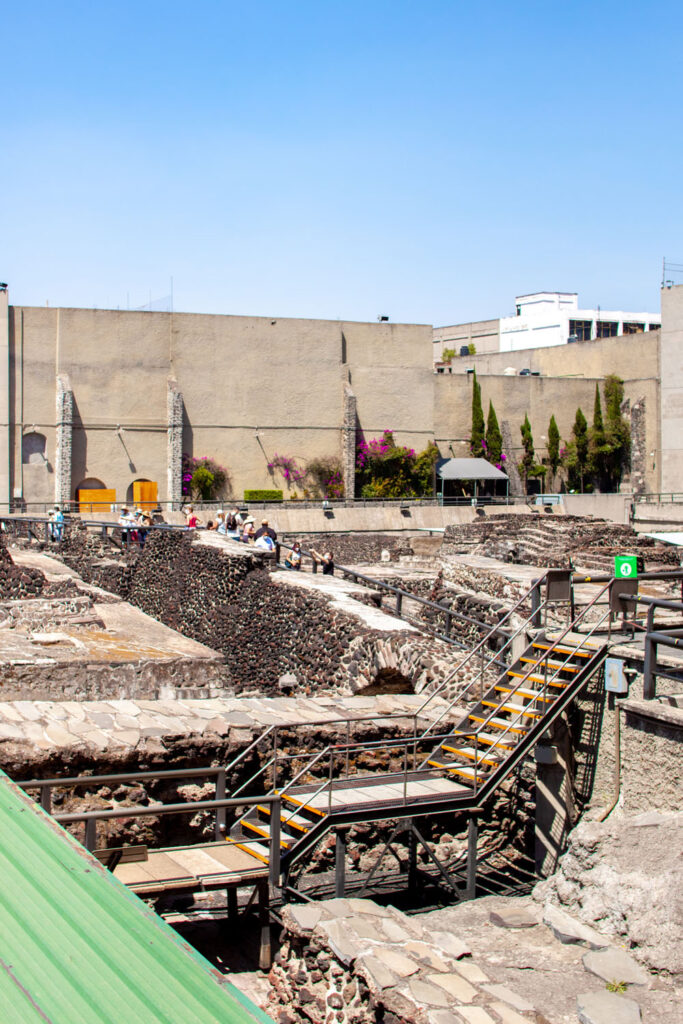
Self-Guided Museum Tour
The Templo Mayor consists of an outdoor Archaeological Zone where the remaining foundations of the original buildings can be seen. Across the site is the Templo Mayor Museum, divided into eight main exhibition rooms. Throughout this space, the Museum highlights aspects of Aztec life and culture and stories told through various artifacts discovered inside this historic site.
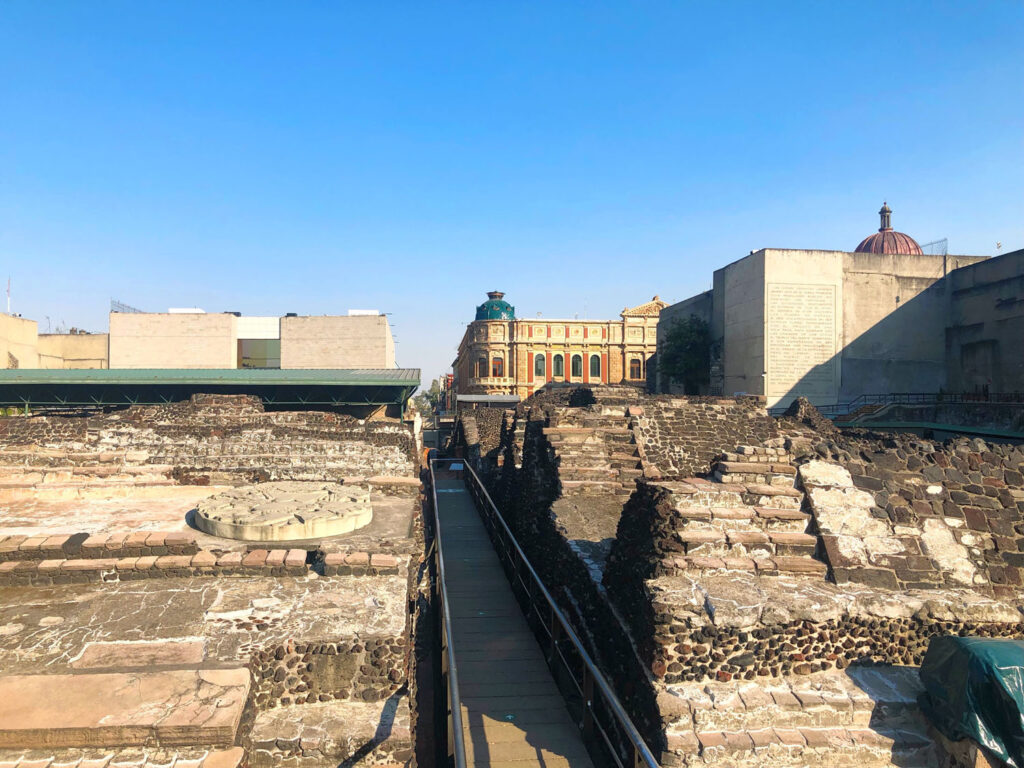
- Self-Guided Museum Tour
- Phase IV
- Coatepantil
- Coyolxauhqui Monument
- Frog Altar
- Stage III
- House of Eagles / Casa de las Águilas
- Tzompantil Altar
- North Red Temple
- Temple of Tlaloc
- Chacmool Statue
- Collector de Agua
- Tlaltecuhtli
- Room 1 – Historical Background
- Room 2 – War and Sacrifice
- Room 3 – Tribute and Trade
- Room 4 – Huitzilopochtli
- Room 5 – Tlaloc
- Room 6 – Flora and Fauna
- Room 7 – Agriculture
- Room 8 – Historical Archeology
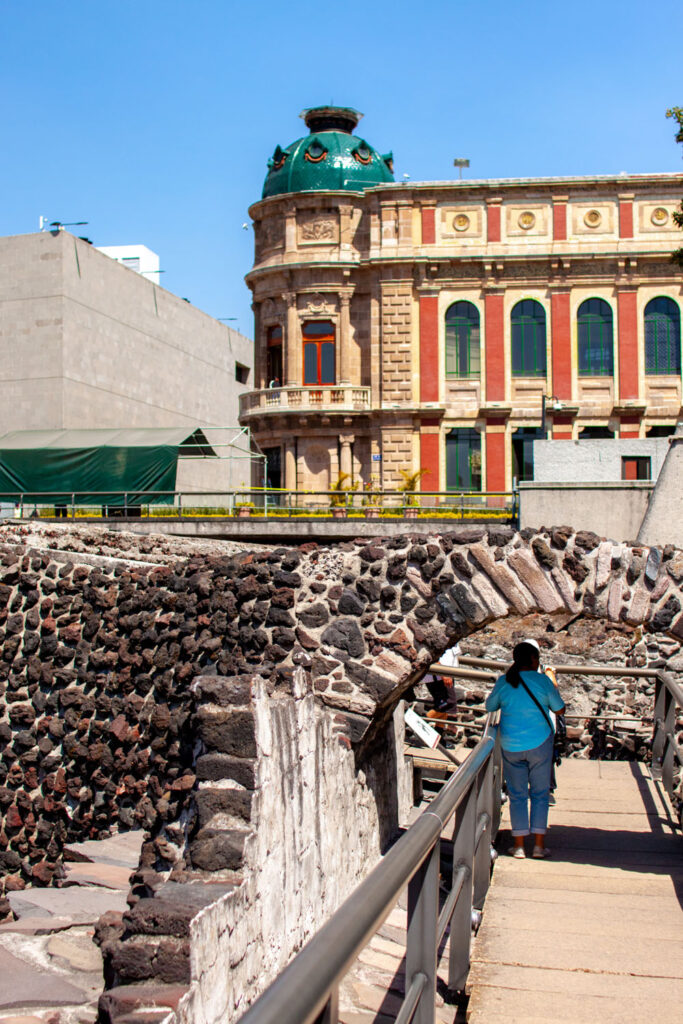
Tips on Visiting Templo Mayor
Hours & Admission
The Museum is open Tuesday through Sunday from 9:00 a.m. to 5:00 p.m. and is Closed on Mondays. Access to the Museum and Archaeological Zone costs $95 Mexican pesos per person ($5 USD). Children under 13 years of age, students, and seniors are free if they can present their current identification.
Sundays offer free admission, but be aware that this is the busiest day at the Museum, with long lines at the entrance. Currently, there is no option for easy online ticket sales for those living outside Mexico.
How to Get to the Templo Mayor
Accessing Templo Mayor is convenient and straightforward. Located in the heart of Mexico City, Templo Mayor is situated just off the Zócalo, the city’s main square, in the Historic Centre. Visitors can easily reach the site by taking the Metro to the Zócalo station (Line 2) and walking a short distance to the entrance. Additionally, there are several bus routes and taxis available, making it accessible from various parts of the city.
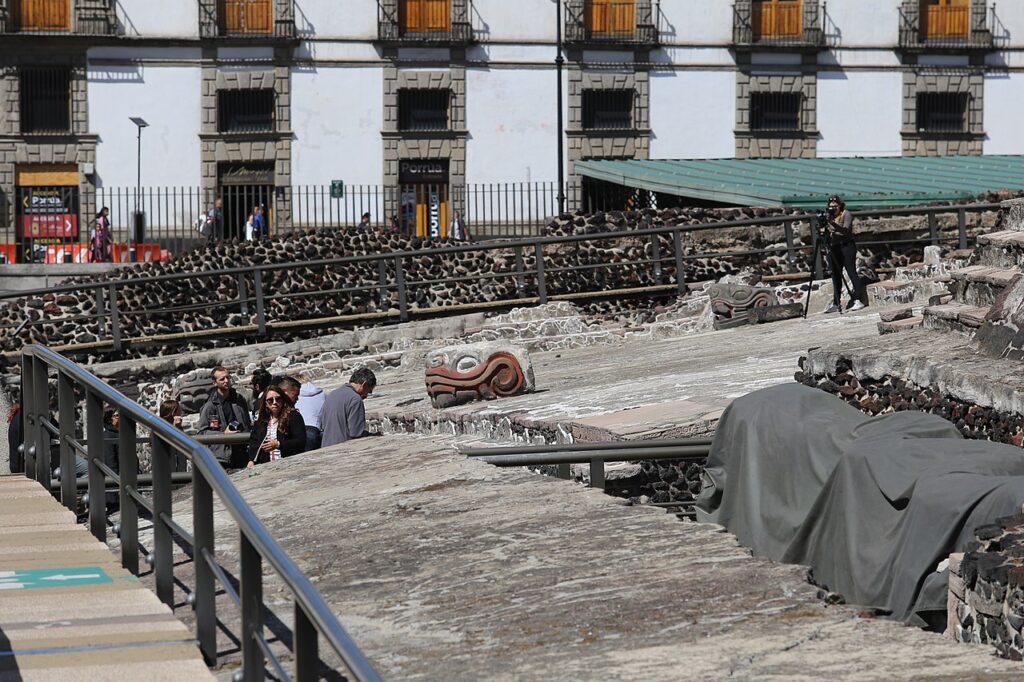
What to Wear / Bring
I’d recommend at least two hours, if not three, for a thorough visit. Because a section of the Museum is outside, you’ll want to dress for the weather with a good wide-brim sun hat in the summer, lots of sunscreen and bottled water. If the weather calls for rain, try to go to the museum part first, as this is indoors and head back outside once the rain has passed. Many areas of the archeological zone are rough underfoot so wear comfortable walking shoes.
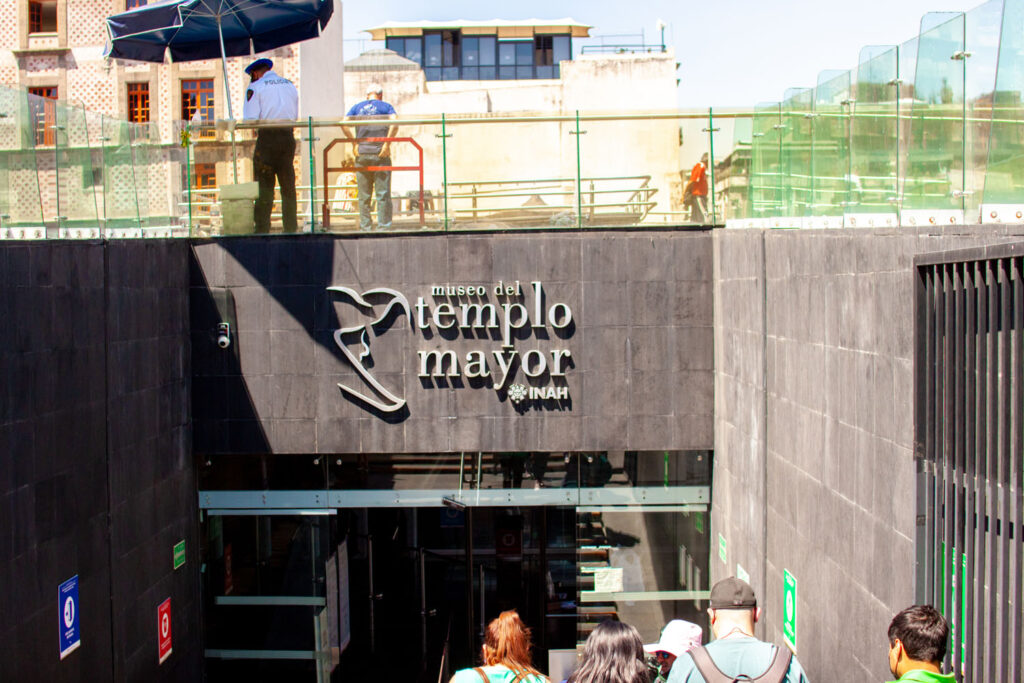
History of the Templo Mayor
Construction on the Templo Mayor began in the 14th century. It was located in the center of the Aztec capital city of Tenochtitlan, now modern-day Mexico City. According to legend, the Aztecs were guided to this spot by their god, Huitzilopochtli, who instructed them to build their city, where they saw an eagle perched on a cactus eating a snake. This image is now so crucial to the Mexican people that it is depicted on the Mexican national flag.

The Templo Mayor’s design consisted of two grand pyramids dedicated to the Aztec Gods Huitzilopochtli, the god of war and the sun, and Tláloc, the god of rain and fertility. The two temples were connected by a double staircase, and the entire complex was surrounded by a large plaza. For the Mexica, the Templo Mayor held the central position in their cosmology, symbolizing the heart of the universe and making its location immutable. Consequently, whenever they sought to expand it, they constructed a new edifice atop the existing one, maintaining its core features: two chapels at the summit and a dual staircase on the main façade. This process was repeated at least seven times, meaning layers of hidden histories are inside.
The shape of the buildings in the Templo Mayor complex was divided into four quadrants, which mirrored the axis mundi of the universe. Today, nothing remains of the pyramids, but the lower-level plaza or sacred precinct and the decorations that adorned this area are what remains to explore.
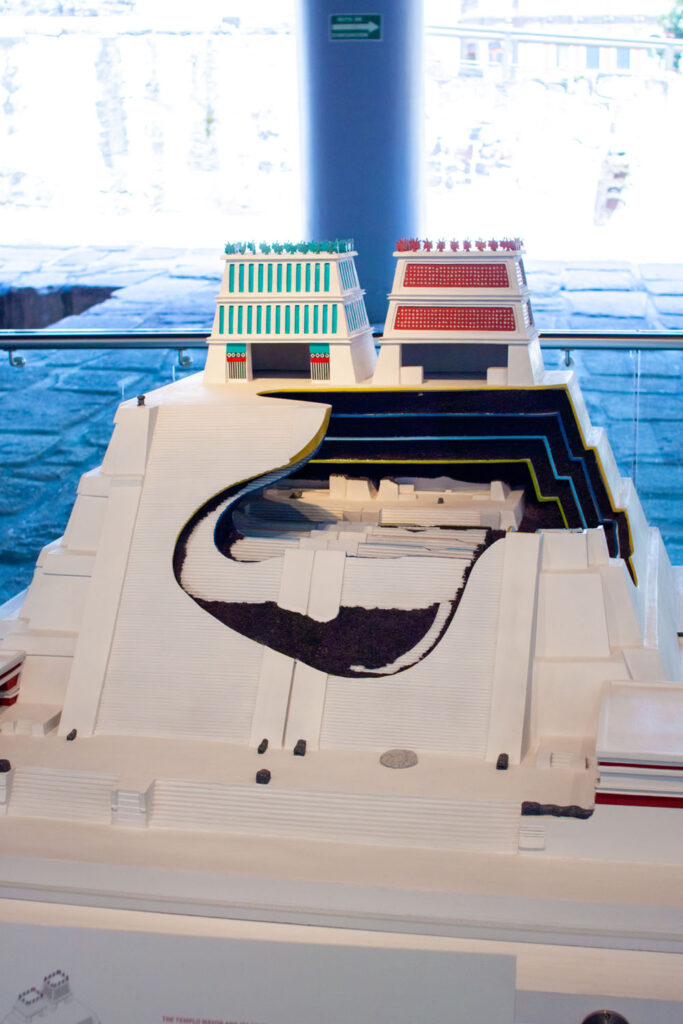
Aztec Life and Culture
The Aztecs were renowned for their complex social, political, and religious systems and impressive architectural and engineering achievements. They had highly developed advanced agricultural techniques, including chinampas (floating gardens), which allowed them to sustain a large population. Their economy was based on agriculture, tribute from conquered regions, and a vibrant market system. Over the next two centuries, Tenochtitlán grew into a powerful city-state that dominated the Valley of Mexico and beyond. The Aztecs formed the Triple Alliance with the city-states of Texcoco and Tlacopan, expanding their influence through conquest and trade.
The Aztecs spoke Nahuatl, which is still spoken by around 1.5 million people in Mexico today. They used a system of pictographic writing to record historical events, religious rituals, and daily life. Codices, or illustrated manuscripts, are valuable sources of information about Aztec culture.
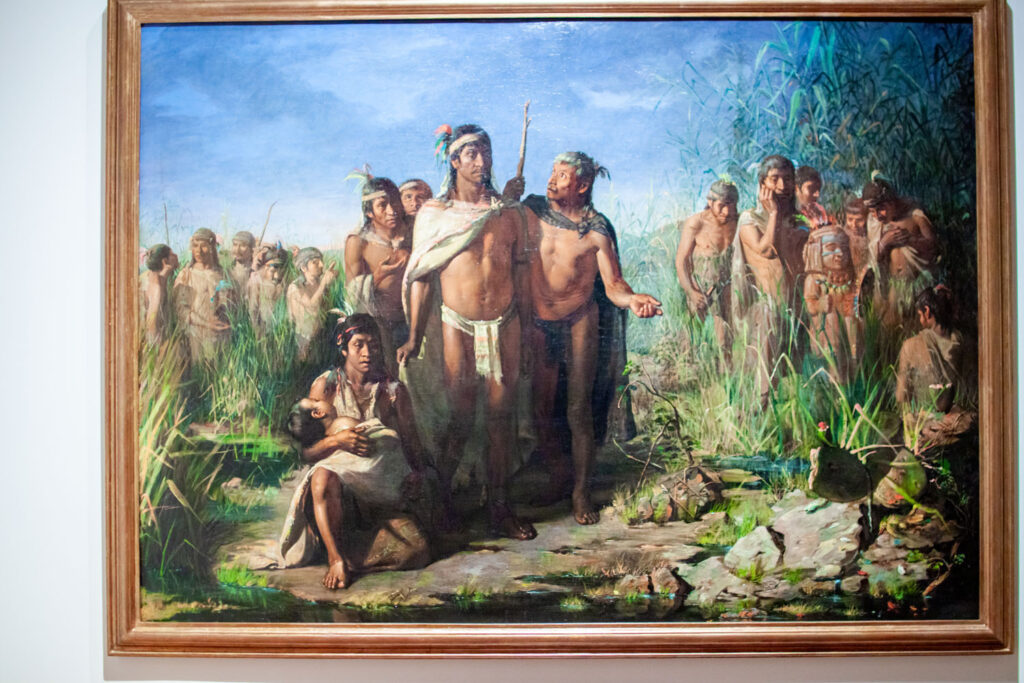
Aztec Religion
The Aztecs had a polytheistic religion with a pantheon of gods, each associated with different aspects of life and nature. Their religious beliefs were deeply intertwined with their cosmology, which envisioned the universe as a precarious balance of forces requiring constant appeasement through rituals and sacrifices.
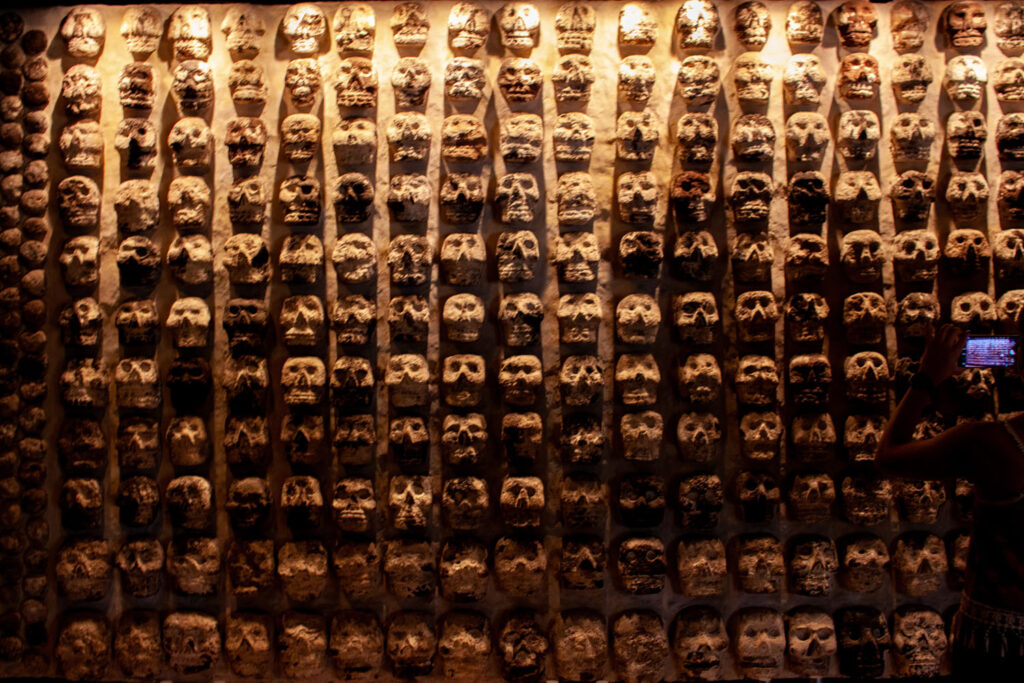
One of the most striking aspects of Aztec religion was the practice of human sacrifice. This was seen as essential to appease the gods and ensure the continuity of the world. The Templo Mayor was dedicated to Huitzilopochtli and Tláloc, two important gods in the Aztec concept of atl-tlachinolli. Atl-tlachinolli, symbolizing the duality of water and fire, is central to Aztec cosmology and intricately tied to their tradition of human sacrifice. Representing the balance between life and death, creation and destruction, atl-tlachinolli underscores the belief that human blood and hearts were necessary offerings to nourish the gods and maintain cosmic order. This duality is reflected in the rituals held at the Templo Mayor, where sacrifices were made to ensure the fertility of the land, the success of military endeavours, and the overall harmony of the universe. The Mexica sought to sustain the gods and renew the cosmos through this practice.
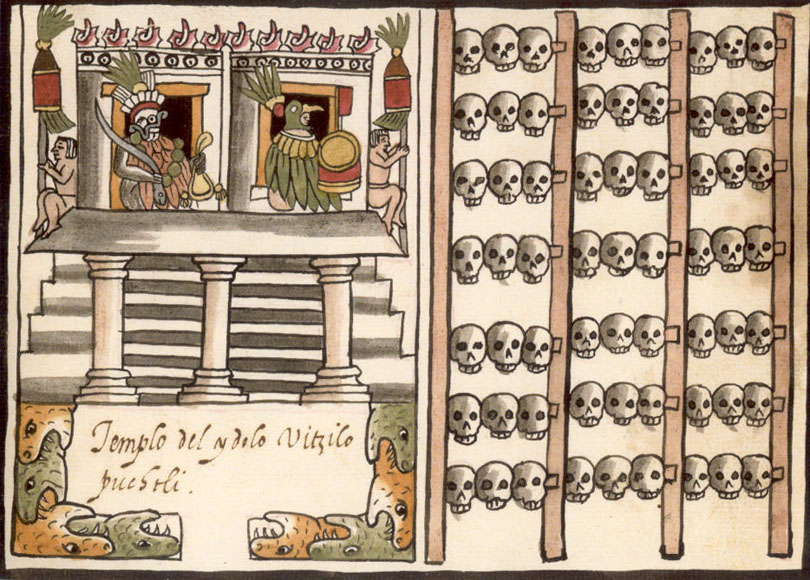
The Fall of Tenochtitlán
After a series of battles and a devastating siege, Tenochtitlán fell to the Spanish in 1521, and the Templo Mayor’s destruction symbolized the Aztec civilization’s collapse. The Spanish built their new city on top of the ruins of Tenochtitlan, which eventually became Mexico City. Not wanting to waste precious material nearly, the Spanish tore apart the pyramids and used pieces of stone from the myriads to construct the new Mexico City Metropolitan Cathedral. After tearing down the great pyramids, the rest of the Templo Mayor lay buried beneath the new city for centuries, and its existence was largely forgotten.
Archaeological Zone & Sacred Precinct
The ruins of the Templo Mayor were discovered in 1978 during electrical work near the Zócalo in Mexico City. Workers unearthed a large stone disk depicting the goddess Coyolxauhqui. This significant find led to extensive excavations by the Mexican National Institute of Anthropology and History, revealing the temple’s twin pyramids and numerous artifacts.
Phase IV
When you enter the Sacred Precinct, you will walk around a series of pathways that guide you around the Archeological Zone. The first area you enter is called Phase IV, constructed in AD 1469-1481 during the reign of Axayacatl, the sixth tlatoani or lord of Tenochtitlan. One of the first buildings you will see is the platform, which is all that remains of one of the two great shines. This platform is decorated with stone carvings of writhing serpents that retain some of their original painted colourings, demonstrating how vibrant these temple complexes would have been when they were first created.
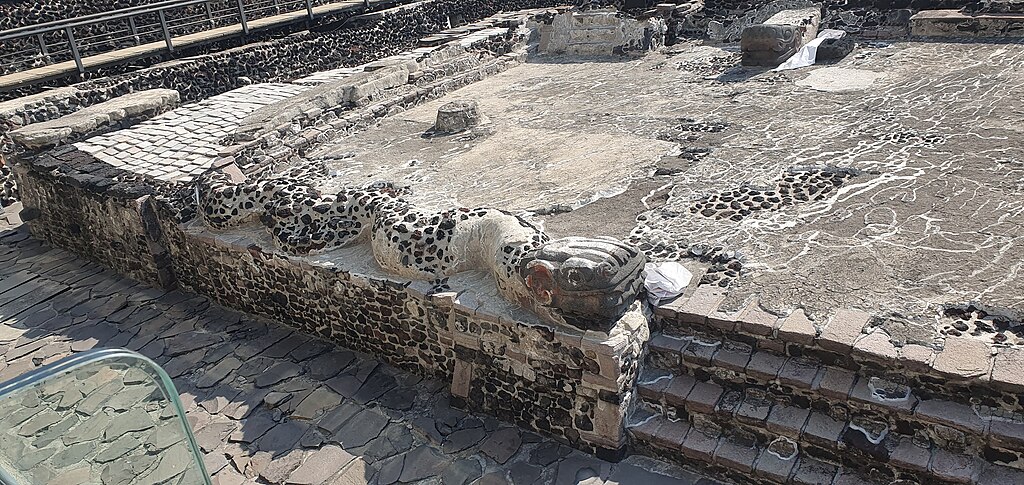
Coatepantil
In addition to the undulating serpents, you can see the Coatepantil, or “wall of serpents,” where carvings of snakes’ heads protrude from the walls. Serpents are so important to the symbology of the Templo Mayor because they are connected with the mythical hill of serpents, Coatepec. According to Mexica mythology, the god Huitzilopochtli was born at Coatepec. At Coatepec, Huitzilopochtli defeated his siblings, including his sister Coyolxauhqui, who had plotted to kill their mother, Coatlicue.
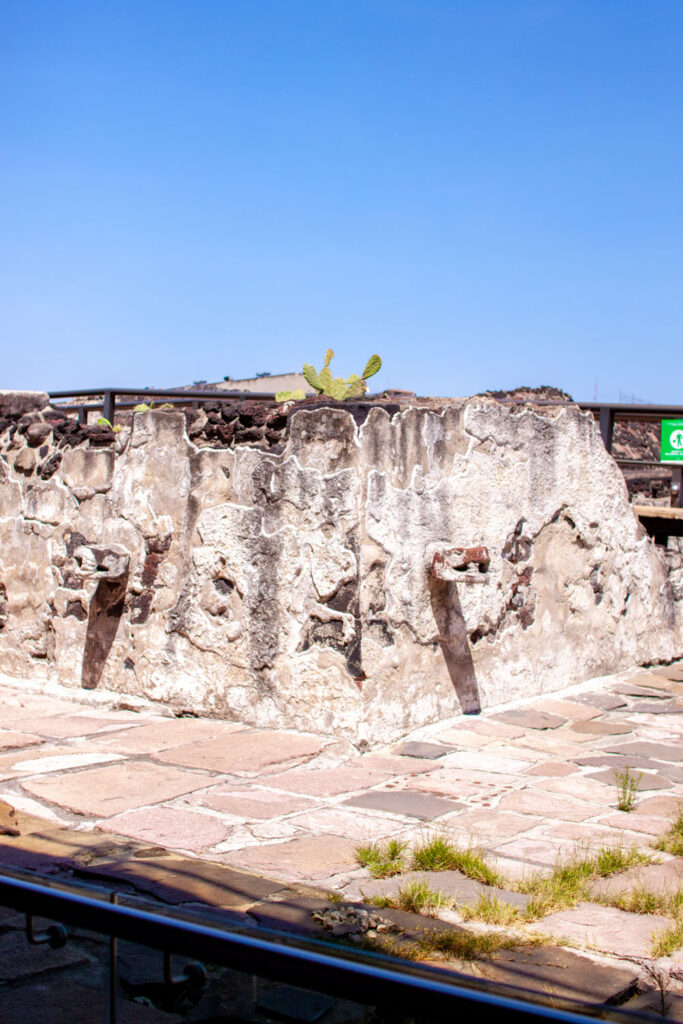
Coyolxauhqui Monument
Atop this platform once stood the great carving of Coyolxauhqui. Today, you can see a recreation of the stone tablet, the original of which can be found inside the museum exhibition space. Coyolxauhqui was a significant deity in Aztec mythology. She was the moon goddess and the sister of Huitzilopochtli, the god of war and the sun. According to the myth, Coyolxauhqui led her 400 brothers, the Centzon Huitznahua (representing the stars), in a rebellion against their mother, Coatlicue. After a ball of feathers touched her, Coatlicue became miraculously pregnant with Huitzilopochtli.
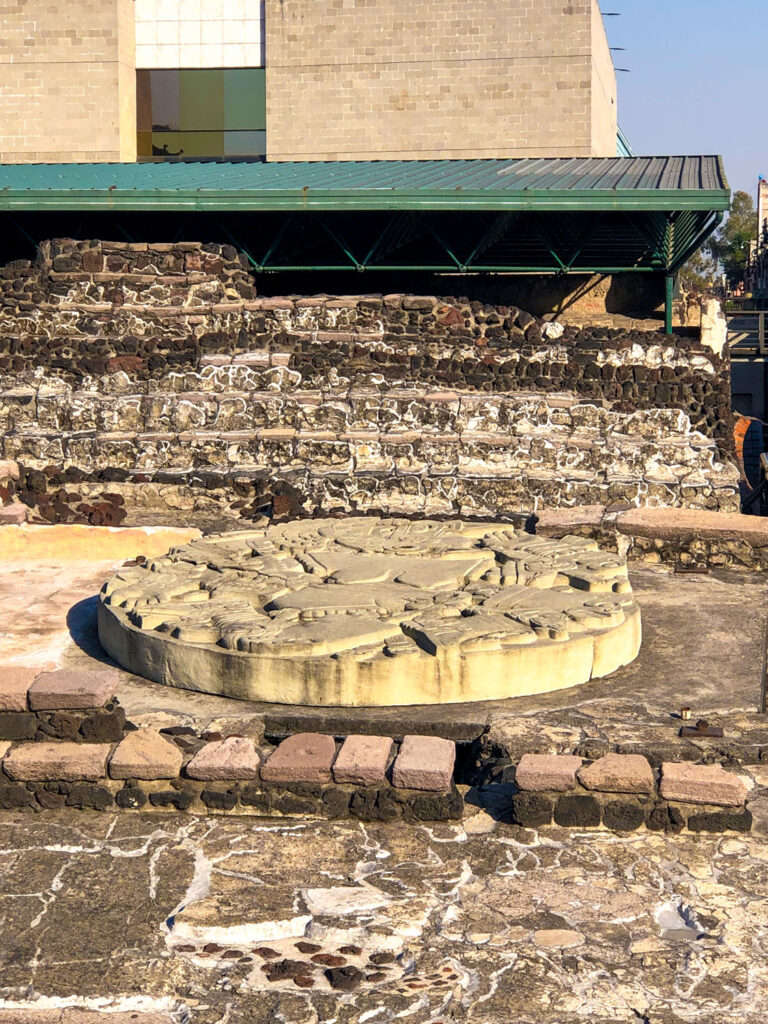
Angered and ashamed by this miraculous pregnancy, Coyolxauhqui and her siblings decided to kill their mother. However, as they attacked, Huitzilopochtli sprang fully armed from his mother’s womb and defeated his siblings. He dismembered Coyolxauhqui, throwing her head into the sky to become the moon. The dismembered depiction of Coyolxauhqui on the stone illustrates her violent end and reinforces Huitzilopochtli’s power and the importance of the Templo Mayor as a site of mythological and religious significance for the Aztecs.
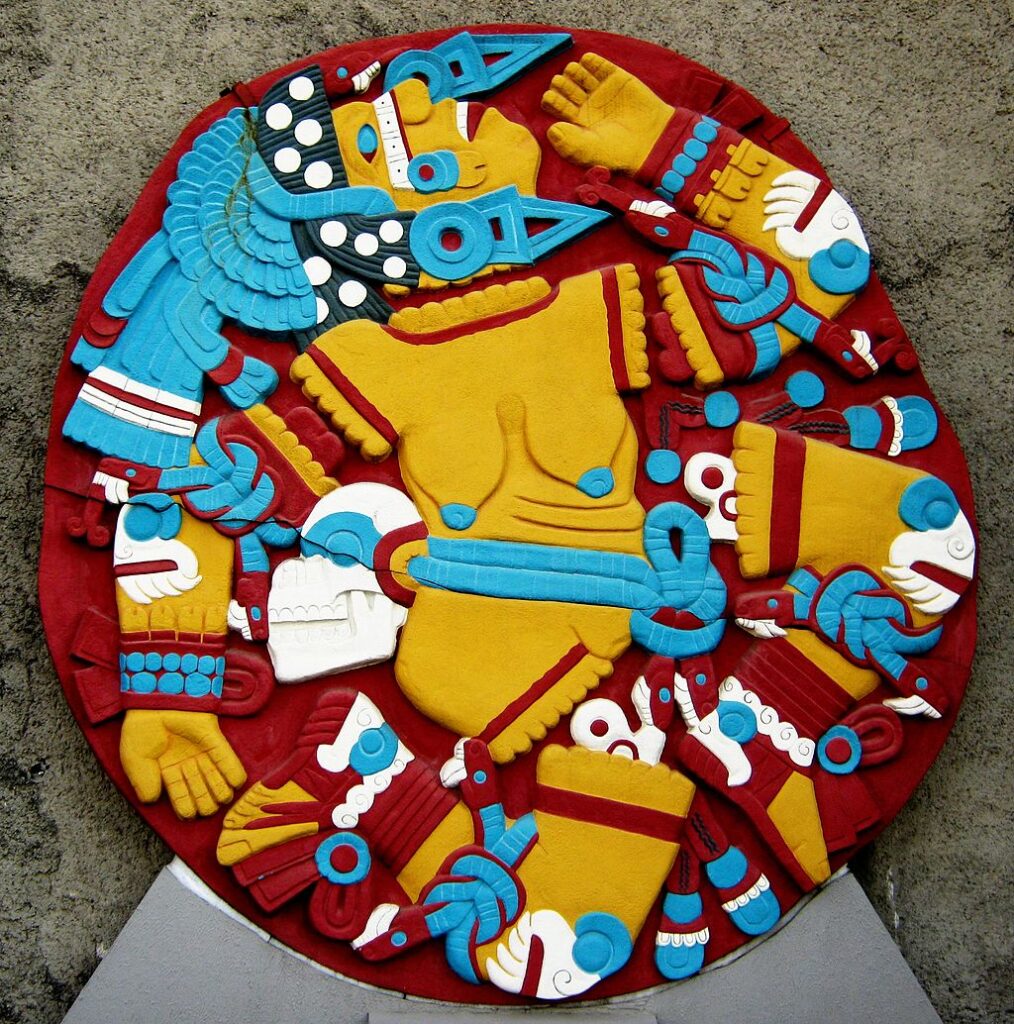
Frog Altar
In this area, look for a pair of frog sculptures in the middle of the shrine, where they appeared on a small altar. The frogs would originally have been painted blue, as they were associated with the water god Tlalc due to their natural connection to water and their behaviour during the rainy season, which aligns with Tlaloc’s domain. Frogs are often seen as harbingers of rain because they become more active and vocal during the rainy season, emerging in large numbers after rainfall. This natural behaviour made them symbols of water, fertility, and the life-giving properties of rain, all under Tlaloc’s purview.
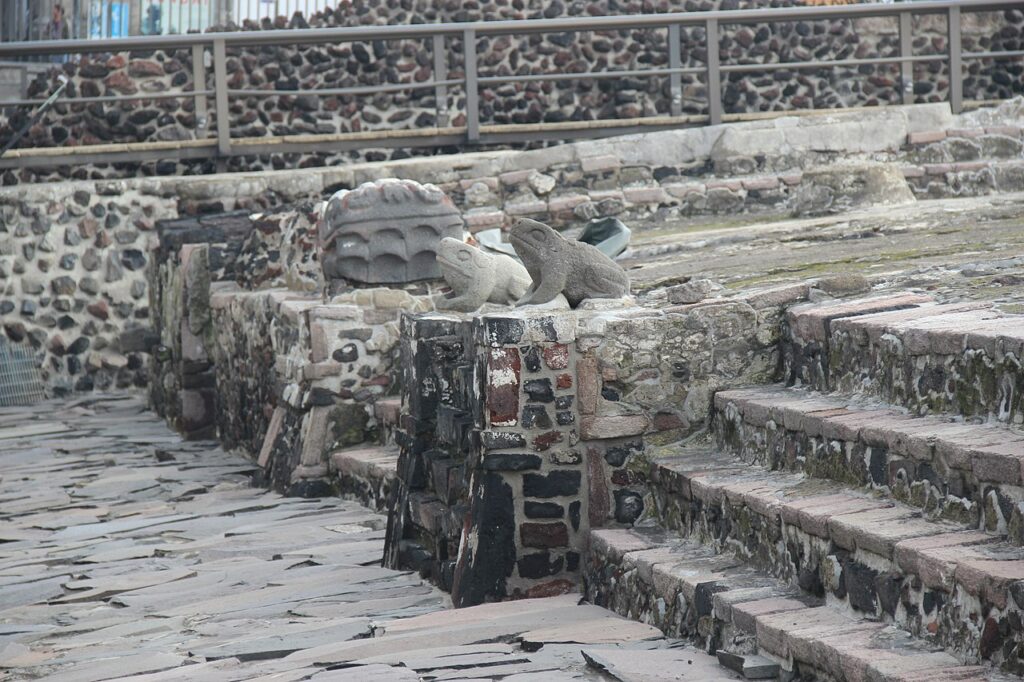
Stage III
Leaning on the stairs in Stage II is a series of human-looking figures leaning against the south side of the building. Centzonhuītznāhua, also known as the “Four Hundred Southerners,” represent the stars of the southern sky and the siblings of Huitzilopochtli, the Mexica god of war and the sun. In Mexica mythology, these deities plotted to kill their mother, Coatlicue but were defeated by Huitzilopochtli at his birth, symbolizing the sun’s triumph over the stars and night. Their defeat highlights the importance of conflict and sacrifice in maintaining cosmic order and balance, key themes in Mexica’s belief.
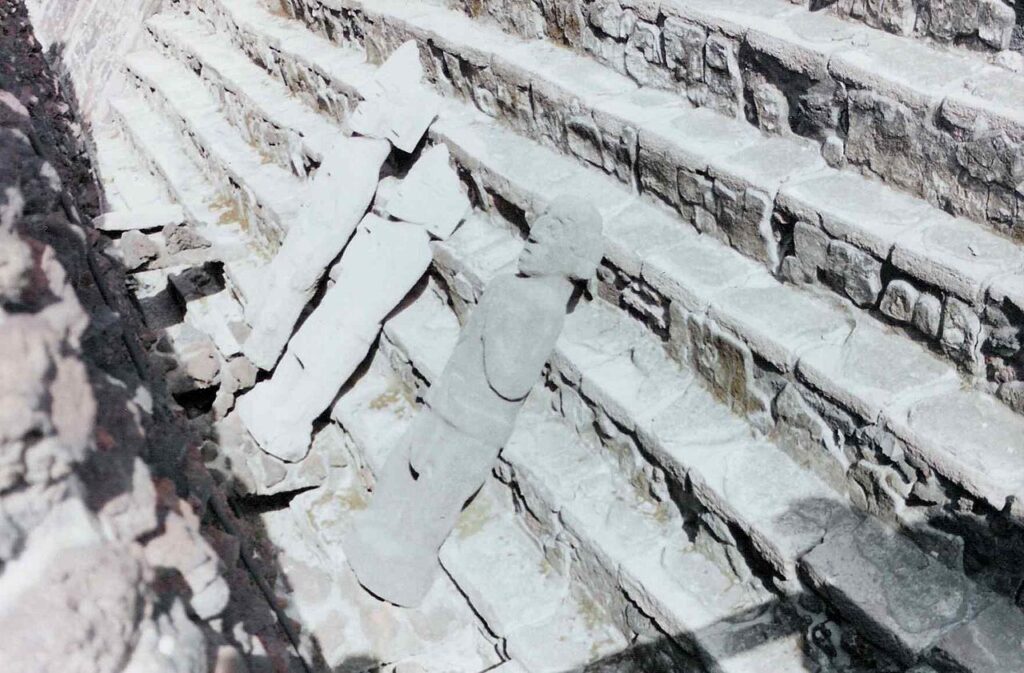
House of Eagles / Casa de las Águilas
One of the shrines still present on the site is the House of Eagles, named after the two eagle heads that flank the exterior of the building, as well as the discovery of several Eagle night statues, men dressed in armour that resemble eagles, which can be seen inside the museum exhibition. Inside the House of Eagles, the walls are decorated with paintings depicting a procession of men, a ritual of penitence, and the rite of self-mutilation.

The House of Eagles served was a vital center for the elite Eagle and Jaguar Warriors, where they convened to deliberate on military strategies and conduct exclusive religious rites. Within its sacred confines, these warriors offered human blood before the idols of Mictlantecuhtli, the Lord of Death, in ceremonies to appease the gods and ensure their favour in battle. Additionally, the precinct was accessible to the Cuahchicqueh, or Shorn Warriors, who also played a significant role in these sacred and strategic gatherings.
Also, inside the house of the eagles, in a room, you can find a four-petaled flower carving with the image of five chalchihuites, precious stones, or jades carved atop it. Chalchihuites, or precious green stones such as jade and turquoise, held profound significance in Mexica culture, as they symbolized wealth, fertility, and divine favour. These stones were highly valued not only for their beauty but also for their symbolic meanings and spiritual associations. As symbols of wealth and high status, chalchihuites indicated prosperity and social prestige, often adorning the elite, including rulers and high-ranking warriors, in elaborate jewelry, headdresses, and ceremonial costumes.

Tzompantil Altar
Continuing to the southeast, you can look at the Tzompantil Altar or the Altar of the Skulls. Tzompantli, or skull racks, were used to exhibit the severed heads of sacrificial victims, often warriors captured in battle, as offerings to the gods. The altar itself was an imposing and macabre sight, with wooden poles and crossbeams filled with rows of skulls, each meticulously arranged to maximize visibility. This display served both religious and socio-political purposes: it was a powerful symbol of Mexica military prowess and a stark reminder of the consequences of opposing their rule.
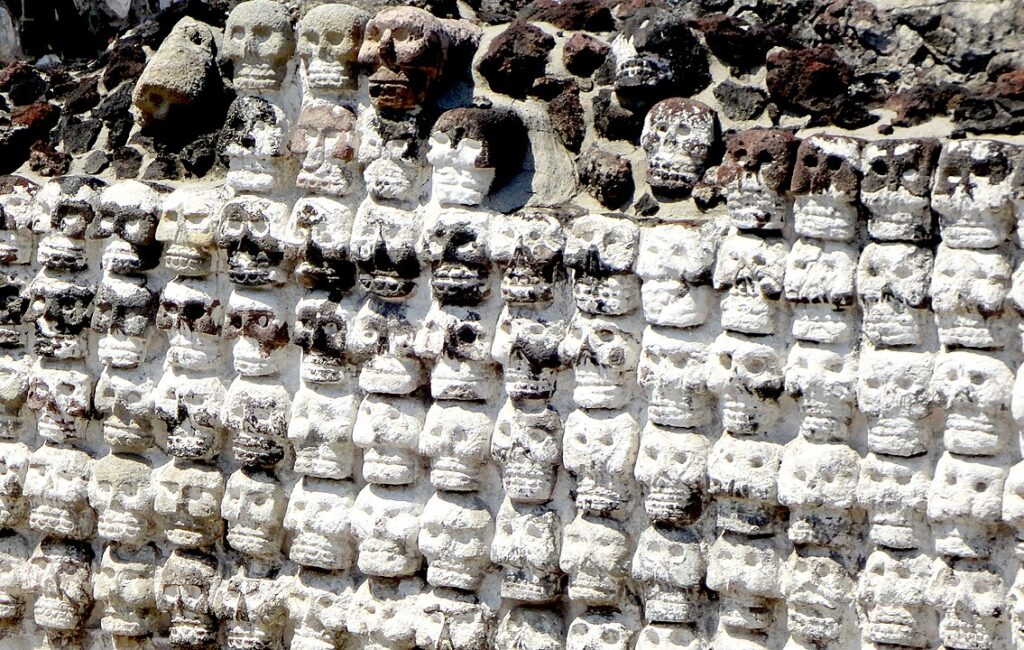
The Tzompantli Altar was closely associated with the worship of Huitzilopochtli, the god of war and the sun, and Mictlantecuhtli, the god of death. Sacrificial rituals conducted at the Templo Mayor were believed to nourish these deities and ensure the continued prosperity and balance of the cosmos. The skulls displayed on the Tzompantli were thought to carry the life force necessary to sustain the gods and, by extension, the Mexica people. This practice underscored the Mexica belief in the cyclical nature of life and death, where the death of captives and sacrificial victims was essential for the regeneration of life and the maintenance of cosmic order.

North Red Temple
The North Red Temple to the east of the Altar of Skulls is a beautiful example of Teotihuacan-style architecture. Inside this shrine is an altar with a relief carved into the front depicting a scene of bodily scarification or self-mutilation using a ball of hay covered in agave thorns. This temple was consecrated to the god Xochipilli. Xochipilli, known as the “Flower Prince,” is a prominent deity in Mexica mythology associated with flowers, love, art, games, beauty, dance, and song. Xochipilli’s name reflects his connection to pleasure and creative expression. Xochipilli is depicted surrounded by flowers and holding objects related to art and beauty, symbolizing fertility and the natural world’s aesthetics.
Temple of Tlaloc
The oldest remnants found in the sacred precinct can be seen outside in stage II, built in 1390. These areas contain the remnants of the Temple of Tlaloc to the north and the Temple of Huitzilopochtli to the south.

Chacmool Statue
At the top center of the Tlaloc temple is a sculpture of a male figure painted in blue and red. This type of sculpture is called a chacmool. A chacmool statue is a distinctive type of Mesoamerican sculpture that features a reclining figure with its head turned to one side, and its knees drawn up. Its elbows rest on the ground, supporting a plate or a bowl on its stomach or chest. These statues are found throughout various Mesoamerican cultures, including the Mexica, Maya, and Toltec civilizations, and they served important ritualistic functions, particularly in sacrificial ceremonies.
The primary purpose of a chacmool was to act as a receptacle for offerings, which often included human hearts or blood, food, incense, and other valuable items intended for the gods. Positioned prominently in temples or other sacred spaces, the chacmool’s bowl or plate was used to hold these offerings during religious rituals. The posture of the figure, with its head turned to the side and its serene expression, suggests a state of receptiveness and submission, reinforcing its role as a conduit between the human and divine realms, a concept that was central to Mesoamerican spirituality.
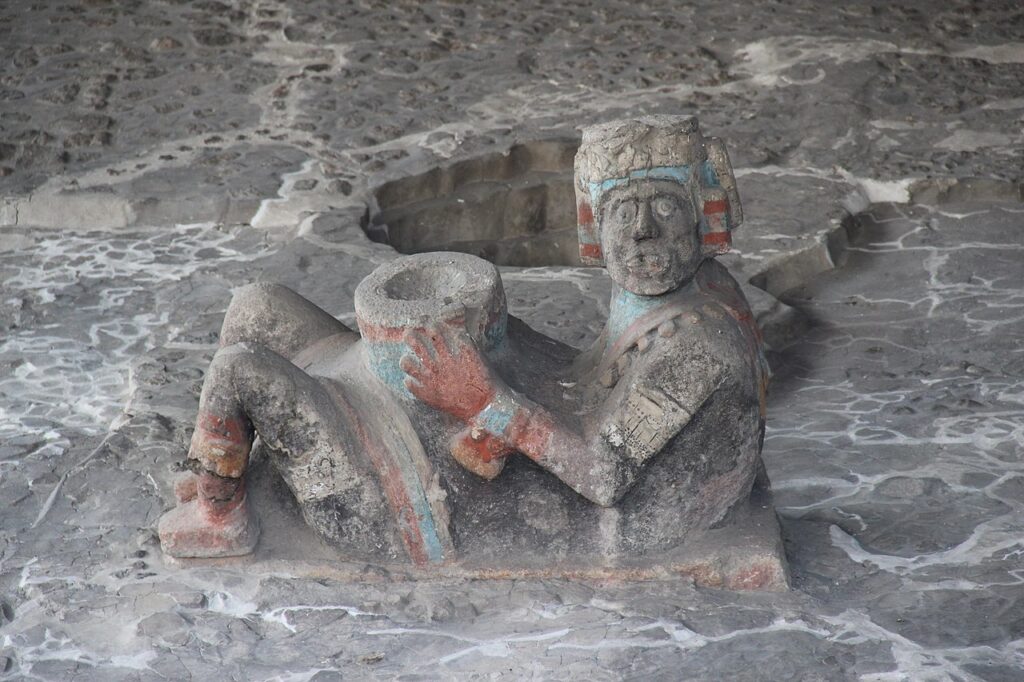
The Brasero Tlaloc
One of the most impressive objects found in the sacred precinct is the Tlaloc Brazier. The polychrome statue was used in rituals to honour the god Tlaloc and ensure the provision of rain necessary for crop growth and agricultural fertility. The image of Tlaloc is wearing a headdress and a diadem of chalchihuites or precious stones and crowned in feathers.
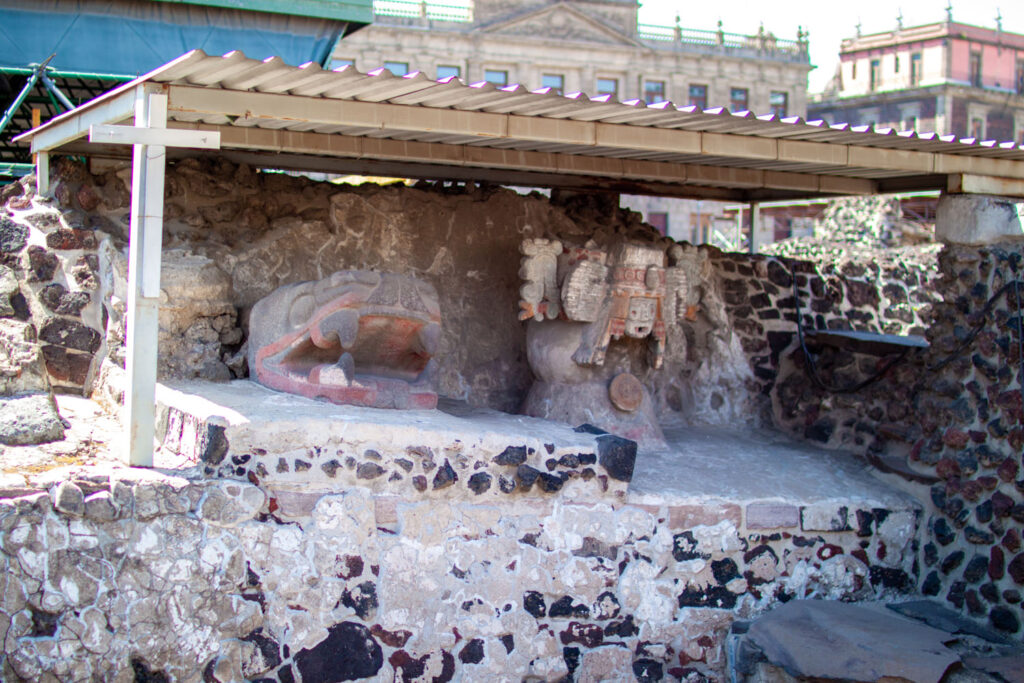
One of the best ways to identify the god Tlaloc is by the circular and bold eye rings. The practical implications of these rituals, such as ensuring agricultural fertility, were a testament to the deep understanding and application of natural principles in Mesoamerican culture.
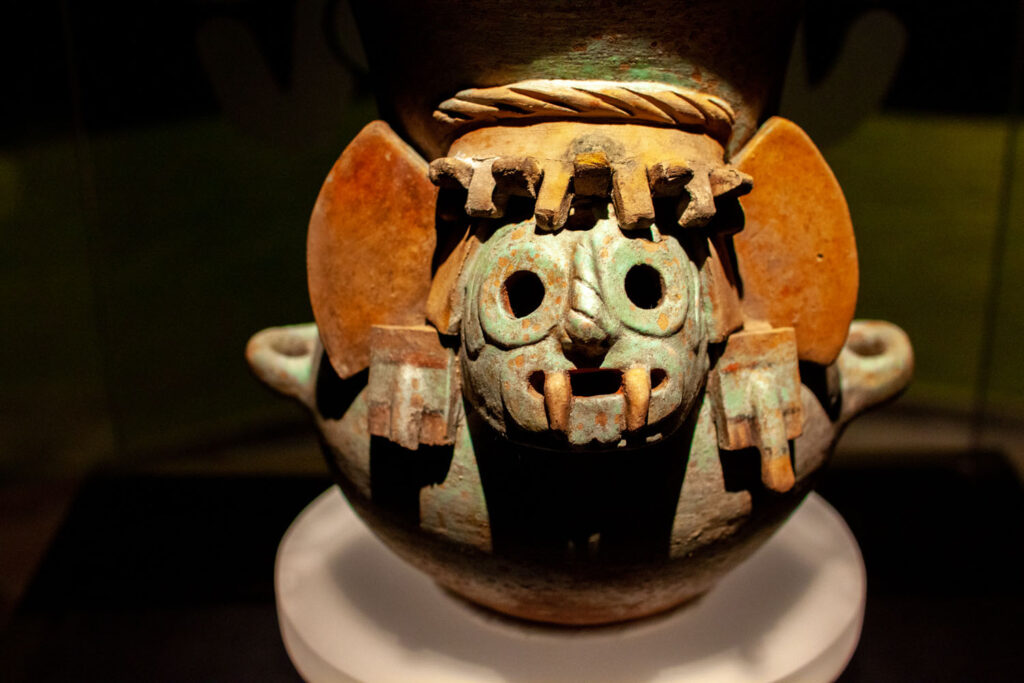
Temple of Huitzilopochtli
Right beside the temple of Tlaloc is the Temple of Huitzilopochtli. Huitzilopochtli was the god of war and the sun, and the Temple of Huitzilopochtli is characterized by its imposing and elaborate architecture, which reflects the importance of the deity it honours. It was a stepped pyramid, rising in several tiers, and accessed by a grand staircase leading to the summit temple. This elevated position symbolized Huitzilopochtli’s paramount role in the Mexica pantheon as the protector of the Mexica people and the bringer of the sun.
Rituals and ceremonies at the Temple of Huitzilopochtli were central to Mexica religious life. These rituals often involved human sacrifices, which were believed necessary to nourish the sun god and ensure the continuation of the world. Victims, often captured warriors, were sacrificed atop the temple, with their hearts offered to Huitzilopochtli and their bodies sometimes thrown down the steps of the pyramid. These practices were intended to demonstrate the Mexica’s devotion to Huitzilopochtli and to secure his favour in their military endeavours.
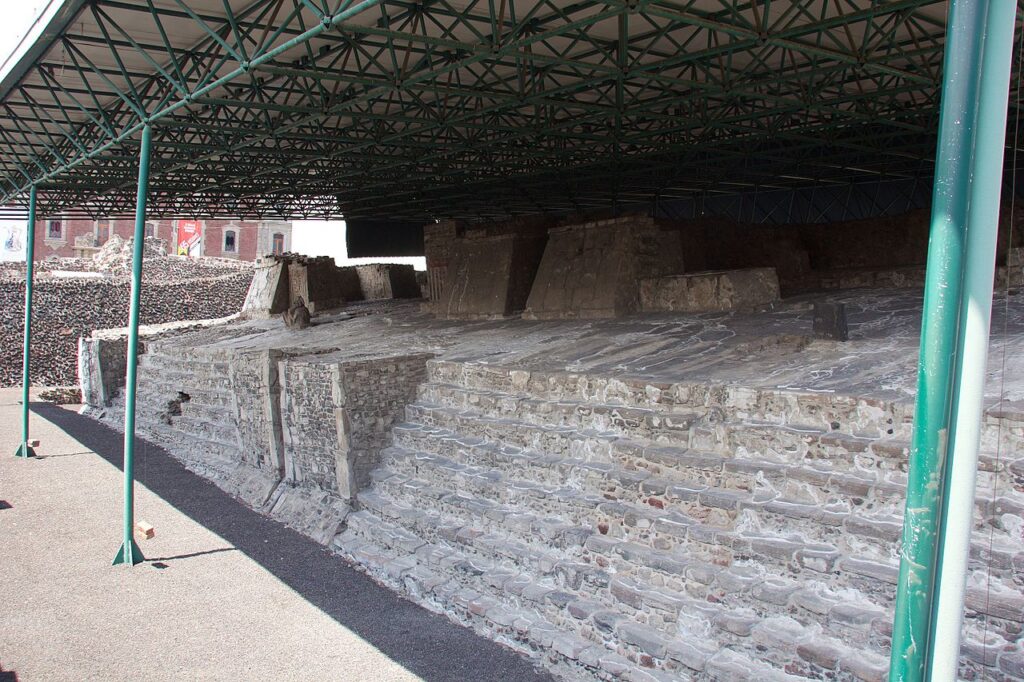
Collector de Agua
As you approach the indoor museum and exhibition areas, you will pass under the various excavated collector de agua, which were the Mexica people’s system to manage and utilize water within the temple complex. This system was essential for both practical and ceremonial purposes, reflecting the importance of water in Mexica religion and daily life. The Templo Mayor’s water collection system included channels, cisterns, and reservoirs designed to capture and store rainwater. These structures ensured a reliable water supply for the temple’s various needs, including cleansing rituals, offerings to the gods, and possibly even the daily use of priests and temple workers. The system’s design demonstrated Mexica’s advanced engineering skills and ability to create functional infrastructure that integrated seamlessly with their religious practices.
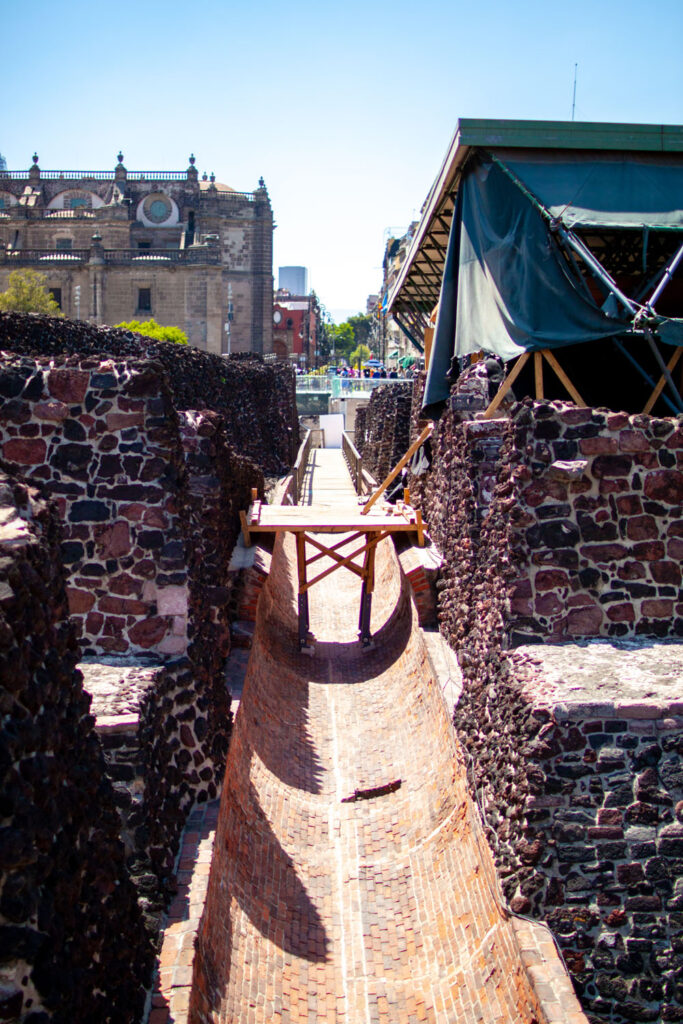
Templo Mayor Museum Exhibition Walkthrough
The Templo Mayor Museum exhibition space houses an extensive and diverse collection of artifacts providing comprehensive insight into the Mexica civilization, particularly its religious, cultural, and social practices. The Templo Mayor Museum houses an impressive collection of over 7,000 objects discovered during excavations of the Templo Mayor site in Mexico City. These artifacts include effigies, clay pots, skeletons of various animals, snail shells, coral, gold, alabaster, Mixtec figures, ceramic urns from Veracruz, masks from Guerrero, and copper rattles.
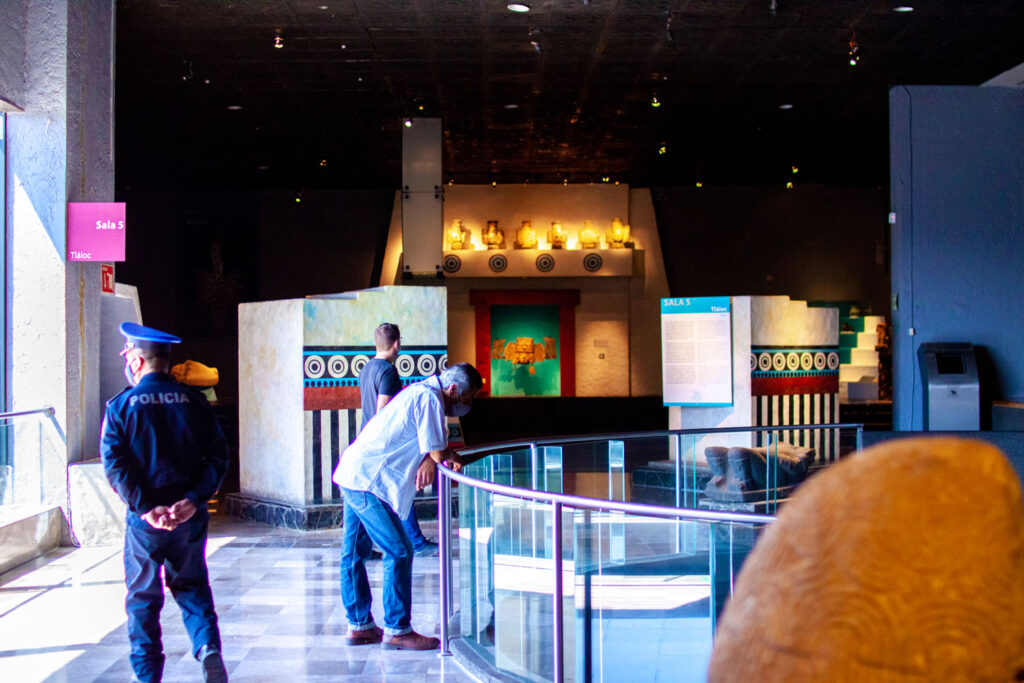
Tlaltecuhtli
When you enter the space, look down from the top of the lobby into the space below, where you can see an imposing statue of the Earth Goddess, Tlaltecuhtli. Tlaltecuhtli, often called the “Earth Lord,” is a significant deity in Mexica mythology, representing the earth and its fertility. Tlaltecuhtli is typically depicted as a monstrous figure with gaping jaws and a body covered in various creatures, symbolizing the earth’s voracious appetite for life and death. This deity is associated with both creation and destruction, embodying the earth’s power to give life through fertility and to reclaim it through death. The Mexica believed that human sacrifices were necessary to appease Tlaltecuhtli, ensuring the fertility of the land and the continuation of life. This monolith weighed almost 12 tons and was once at the foot of the Templo Mayor.
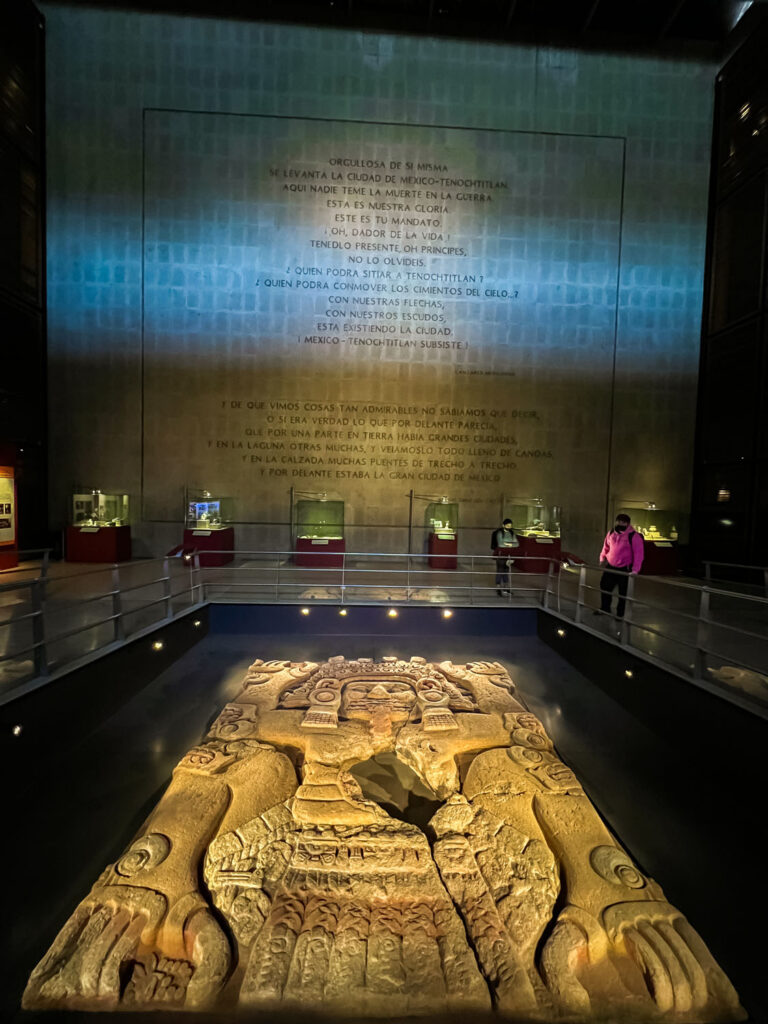
Room 1 – Historical Background
The first room inside the museum provides a historical overview of the temple’s significance, construction, and role in Mexica society. It includes a detailed model of the Templo Mayor complex, maps of the ancient city, and informative panels explaining the temple’s dual dedication to Huitzilopochtli, the god of war, and Tlaloc, the god of rain and agriculture. In addition, a collection of over 100 different offerings deposited by the Mexicas was unearthed during the excavation.
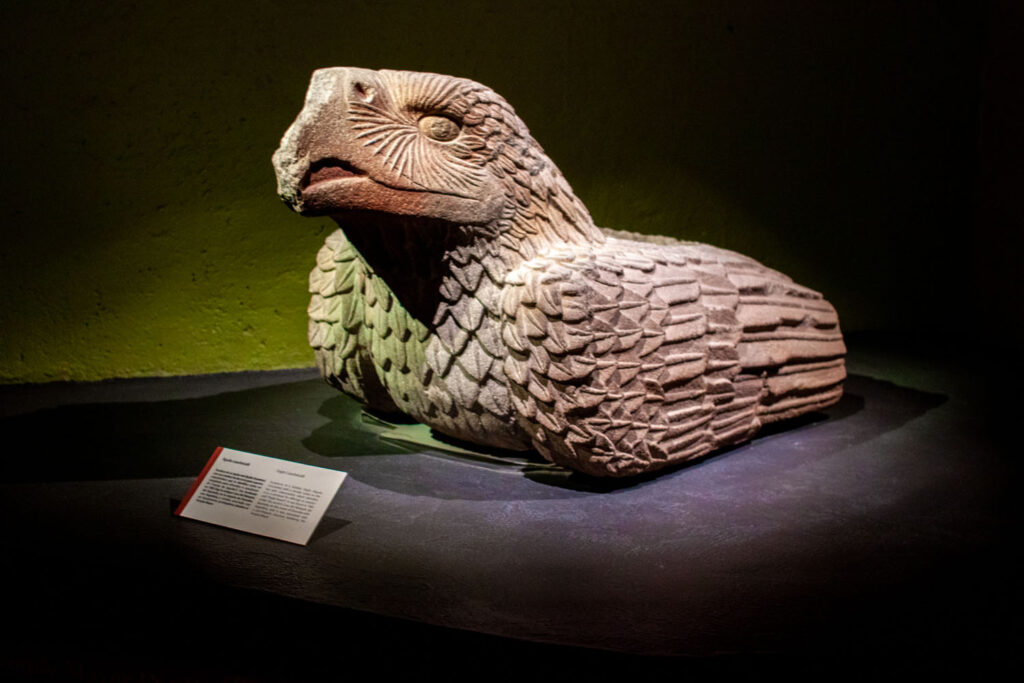
Room 2 – War and Sacrifice
This room delves into the Sacred Precinct, or the ceremonial heart of Tenochtitlan, where the Templo Mayor was located. Artifacts include ceremonial offerings to the gods to gain good favour and improve crops and victory in war. Funerary offerings such as musical instruments, knives, skulls, braziers and green stone masks are displayed throughout the room.
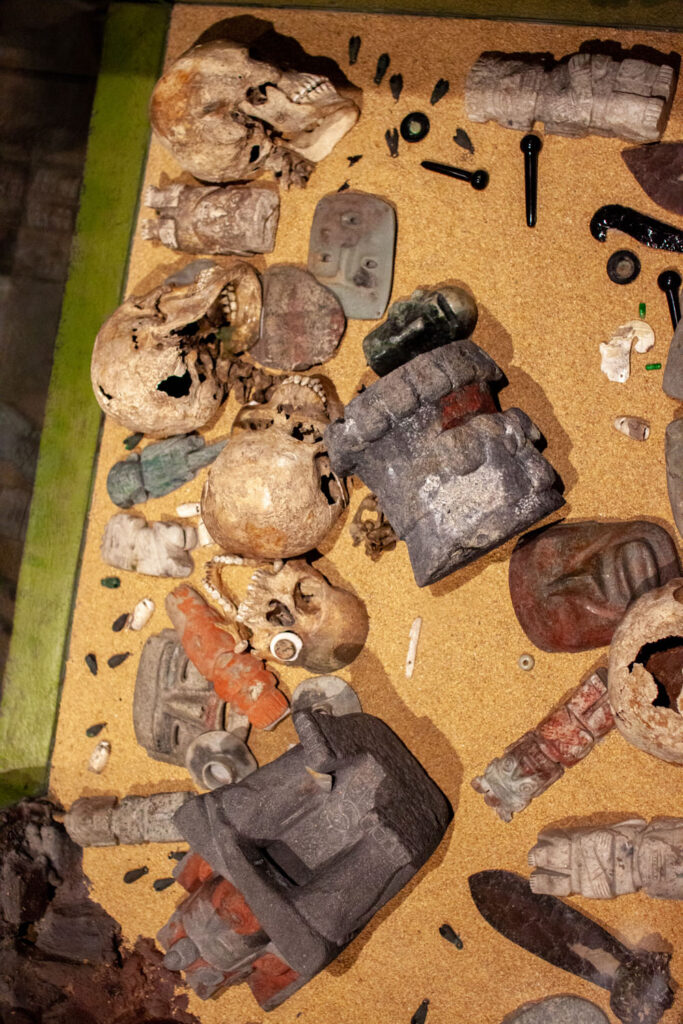
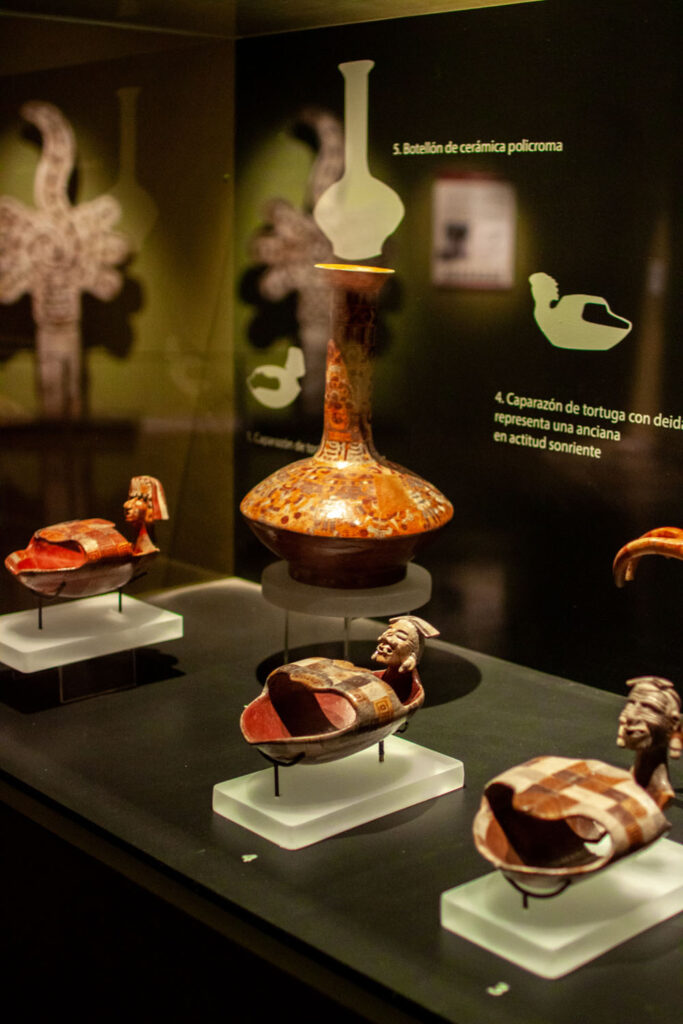
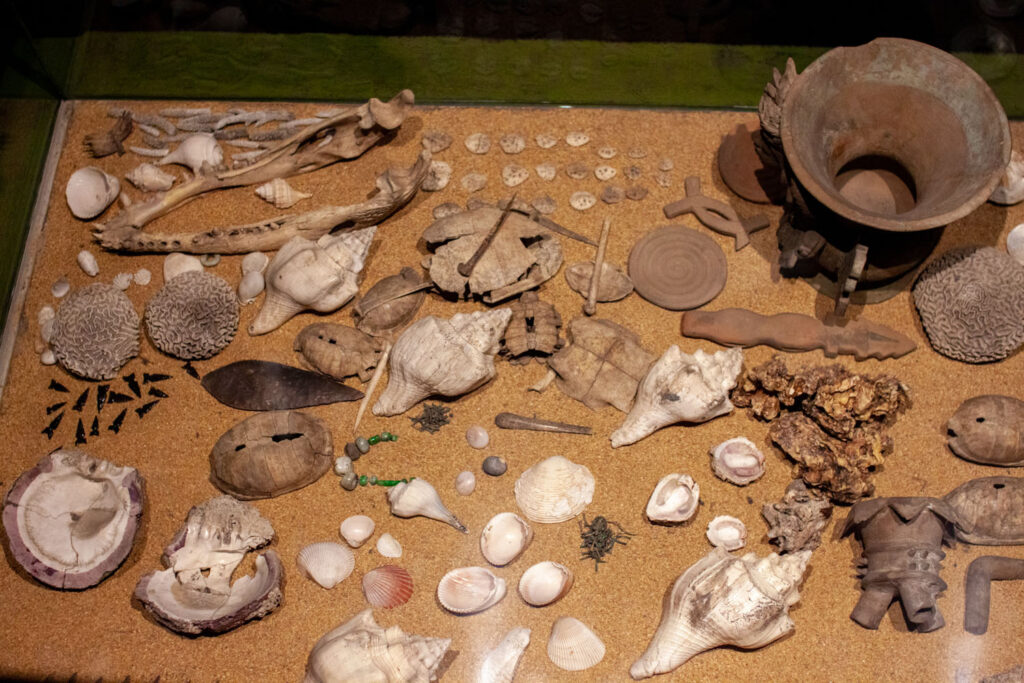
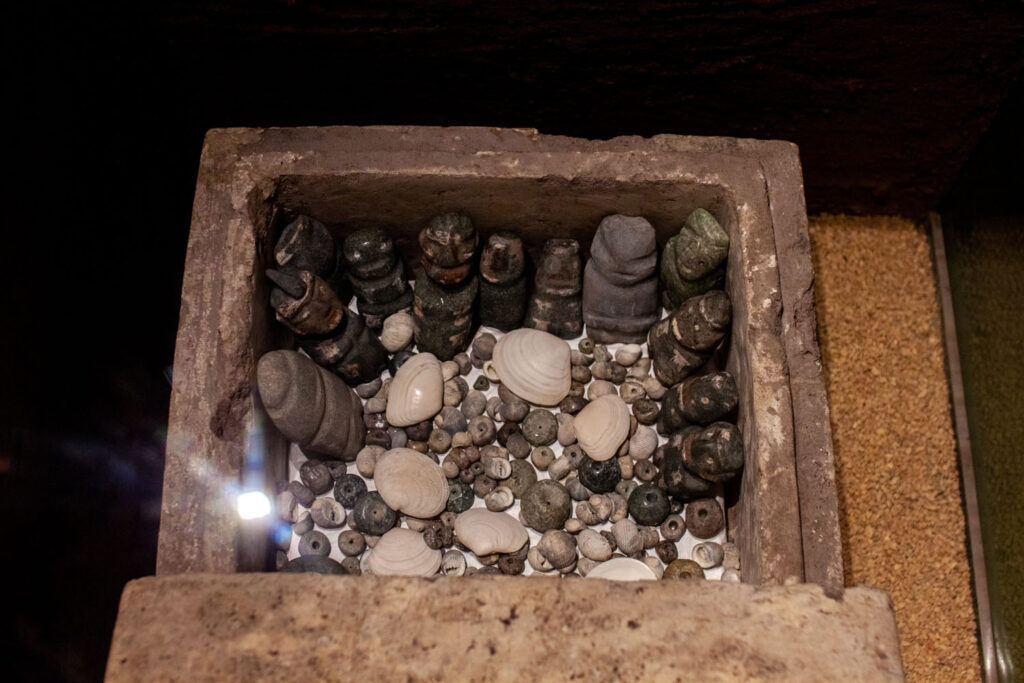
Room 3 – Tribute and Trade
The third room highlights the Mexica people’s economic, political, and military domination from 1430 to 1519 and the objects related to the pochtecas. The financial power of the Mexica people was primarily due to the pochtecas, who were professional merchants and traders in the Aztec Empire. They travelled long distances to procure luxury goods such as precious stones, feathers, cacao, and exotic textiles, which were highly valued by the elite. Besides their commercial activities, pochteca acted as spies and diplomats, gathering intelligence on rival states and facilitating regional communication. Their wealth and specialized knowledge afforded them a high status within the Mexica society, and they operated within organized guilds that maintained strict regulations and traditions.
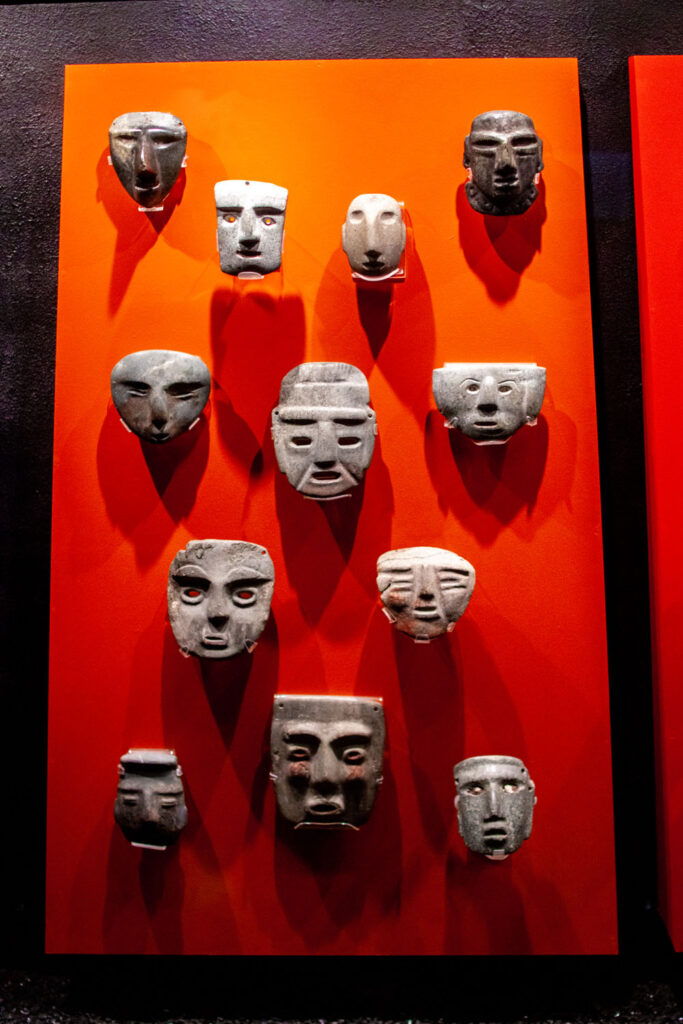
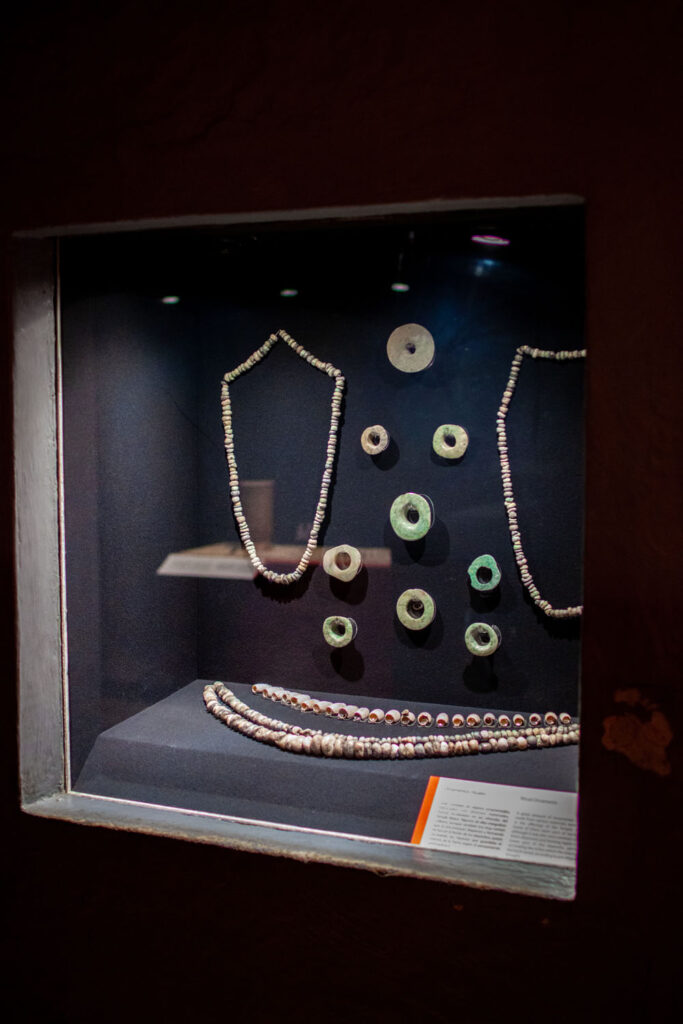
Room 4 – Huitzilopochtli
In this room were found pieces related to the god Huitzilopochtli. You’ll also find a ceramic sculpture of an eagle warrior once housed inside the House of Eagles and a series of stone sculptures representing the Centrzonhuitznahua, Huitzilopochtli’s brothers. These are the same sculptures as you would have seen recreations of outside. The Centzonhuitznahua, also known as the “Four Hundred Southerners,” were stars in the southern sky and, along with their sister Coyolxauhqui, plotted to kill their mother, Coatlicue, after she became miraculously pregnant with Huitzilopochtli. However, Huitzilopochtli was born fully armed and defeated his siblings, symbolizing the sun’s triumph over the stars and the moon. This myth underscores the cosmic struggle between light and darkness in Mexica cosmology.
One of the most important pieces in this room is a stone sculpture of fire serpent, Xiuhcoatl, Huitzilopochtli’s weapon. Xiuhcoatl, which translates to “Turquoise Serpent” or “Fire Serpent,” is the weapon wielded by Huitzilopochtli. This mythical serpent is often depicted as a snake-shaped weapon, symbolizing fire and solar power.

The Old Gods
Another two gods important to Aztec culture can be found here. The old god of fire, Huehueteotle, is depicted here. Huehueteotl is a deity representing the ancient and enduring aspects of fire. Often depicted as a wizened old man carrying a brazier, Huehueteotl symbolizes the life-sustaining and transformative power of fire, crucial for warmth, cooking, and rituals. His imagery often shows him with a solemn expression, emphasizing his connection to the ancient past and the cyclical nature of time.
There is also a sculpture of Mictlantecuhtli, the god of the dead. Mictlantecuhtli was the ruler of Mictlan, the underworld. Often depicted as a skeletal figure adorned with bones and jewelry, he embodies death and the afterlife. His domain is the final destination for most souls, where the dead journey through nine levels of challenges to reach rest. Mictlantecuhtli’s imagery, with a skull face and empty eye sockets, emphasizes his association with death, darkness, and the inevitable end of life, playing a crucial role in Mexica beliefs about mortality and the afterlife.
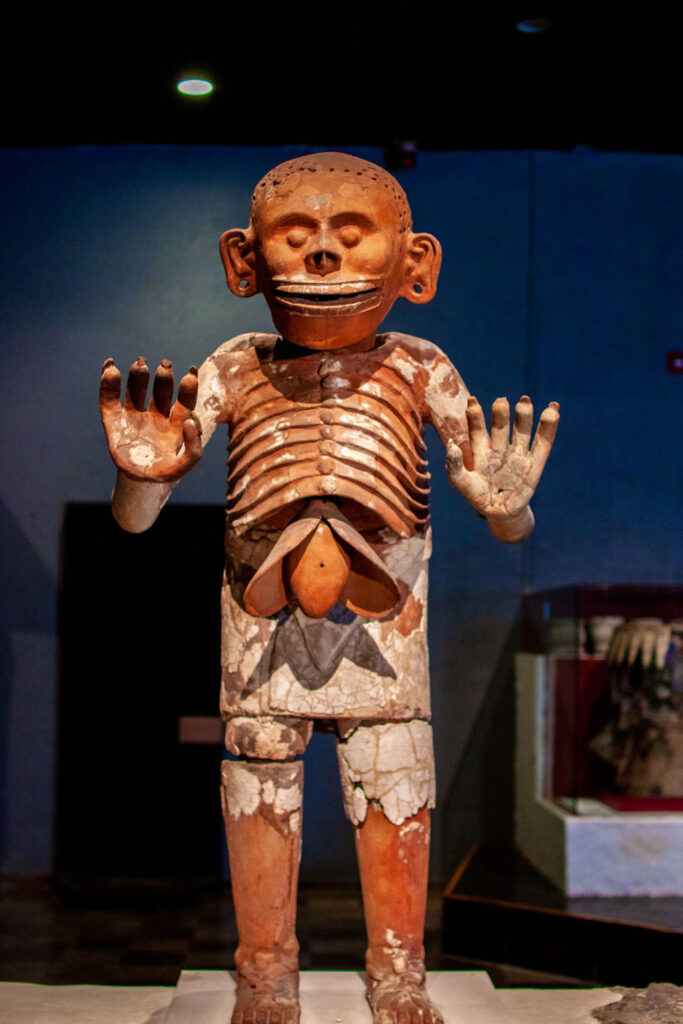
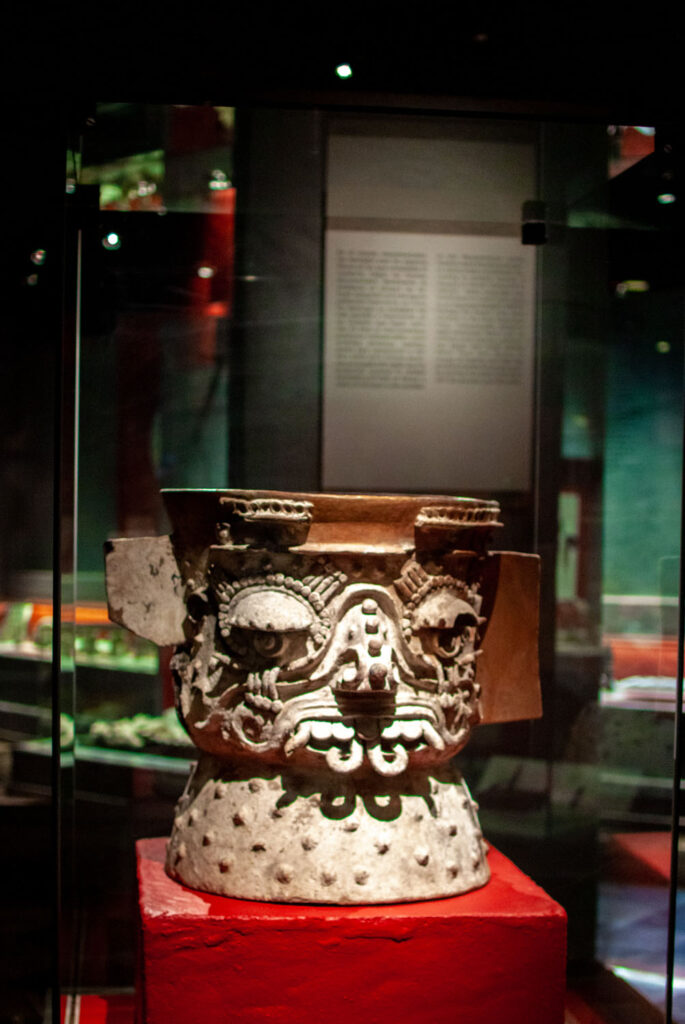

Between rooms 4-5, you can see the original monolith of the goddess Coyolxauhqui. This carving is over 3.2 meters wide and is one of the best examples of Aztec art.
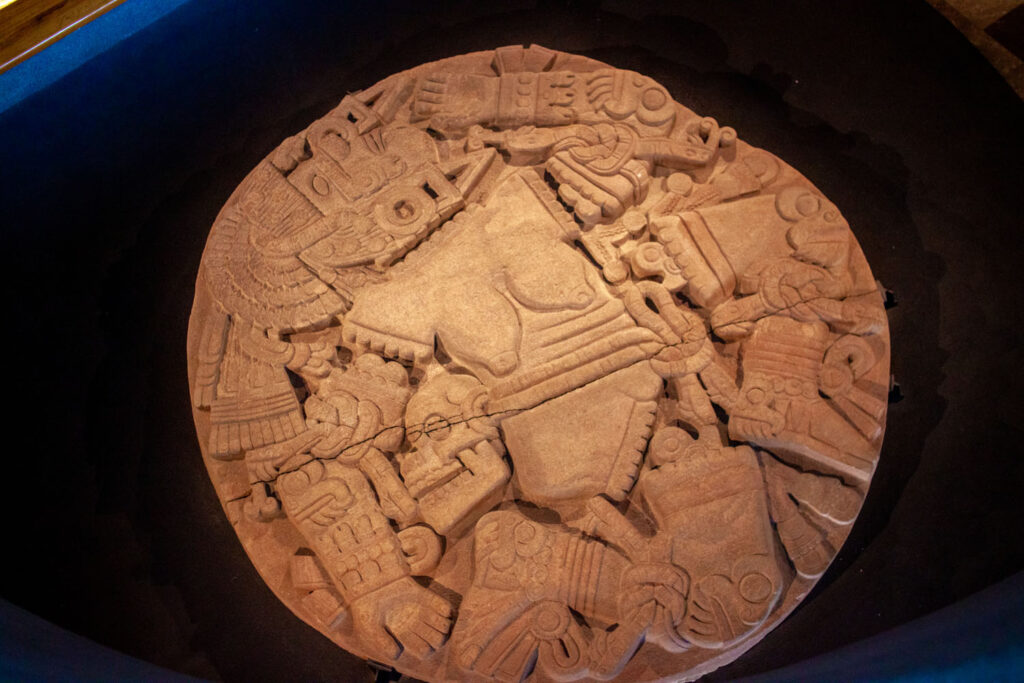
Room 5 – Tlaloc
Inside this room are all the objects gathered that represent the god of Rain, Tlaloc, and objects related to water, harvest, and fertility. Despite Mexico City being in the centre of the country, there are a surprising number of marine symbols present, such as conch shells carved from volcanic stone and fish carved from mother of pearl.
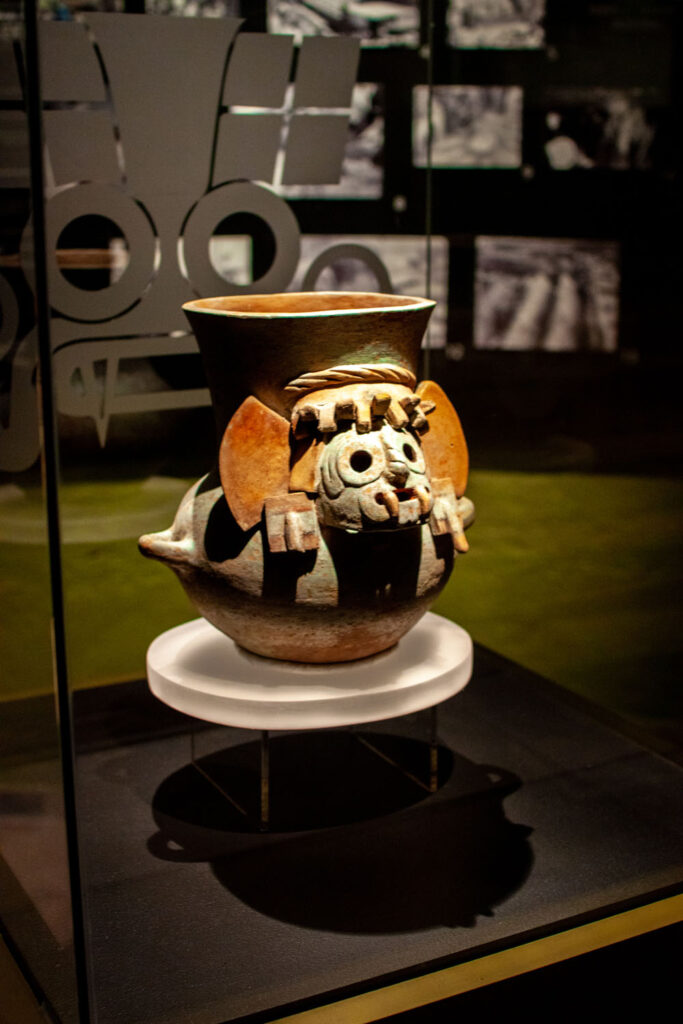
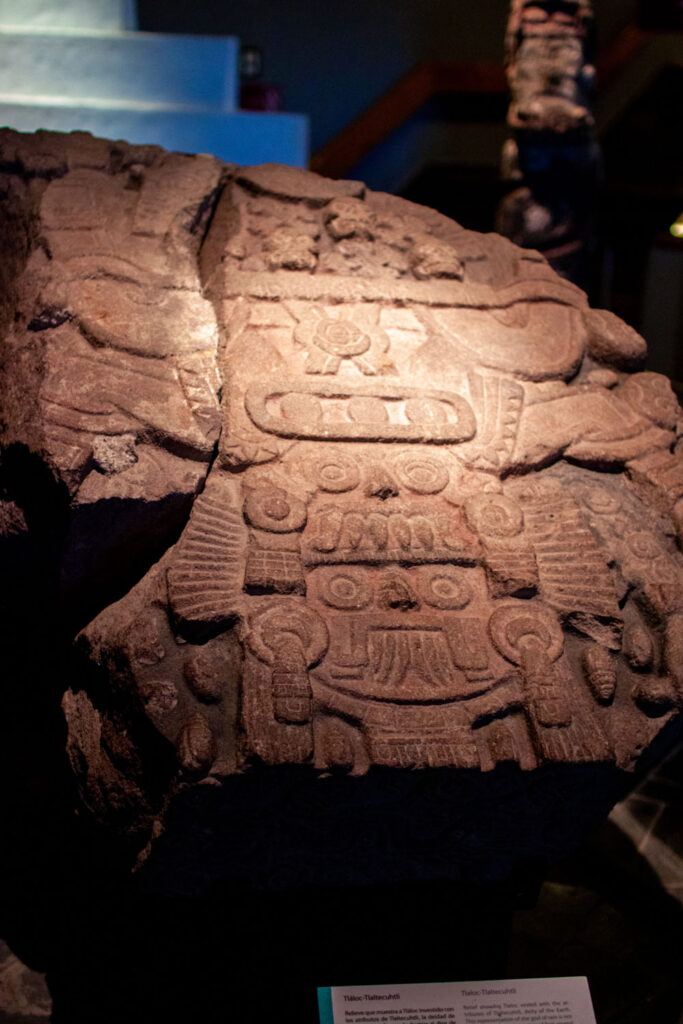
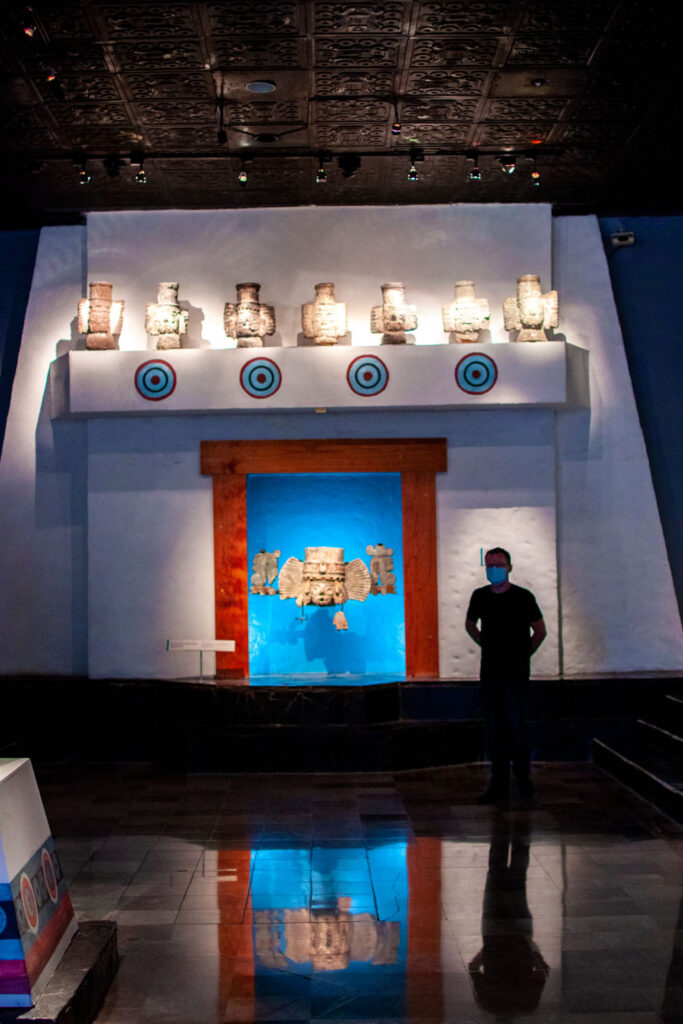
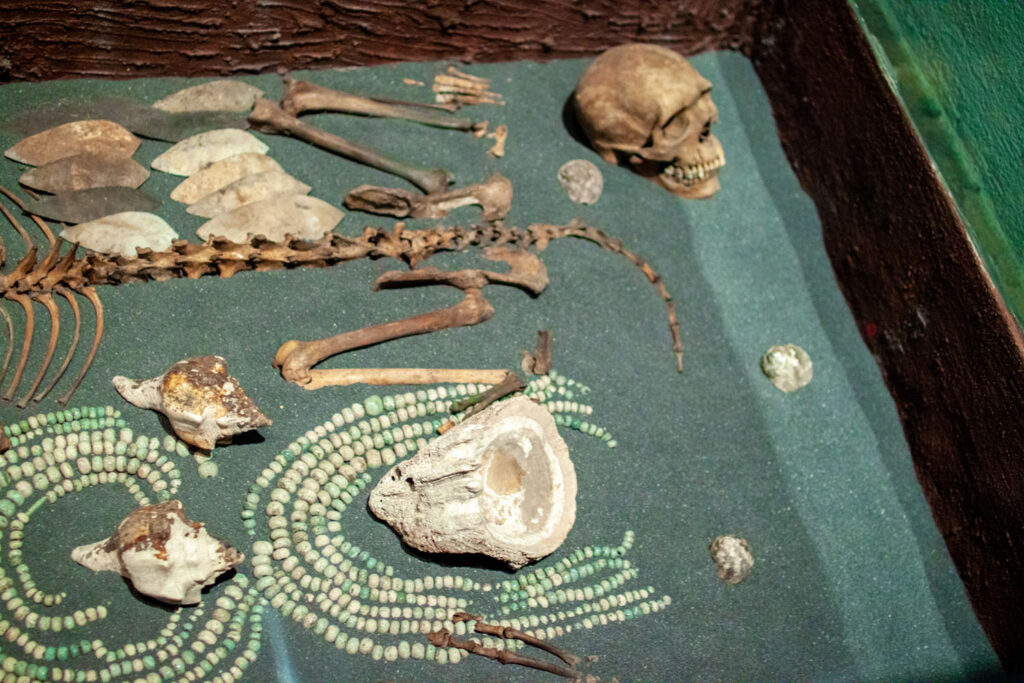
Room 6 – Flora and Fauna
In room six, you can see examples of the ecological environment unique to Mexico and Mexico City. Plants and animals were always a large part of the symbolism in art and the codices of the Aztecs, and many animals were thought to be manifestations of the gods themselves. These exhibition spaces show the viewers the kind of diversity there was in ancient Teotihuacan.
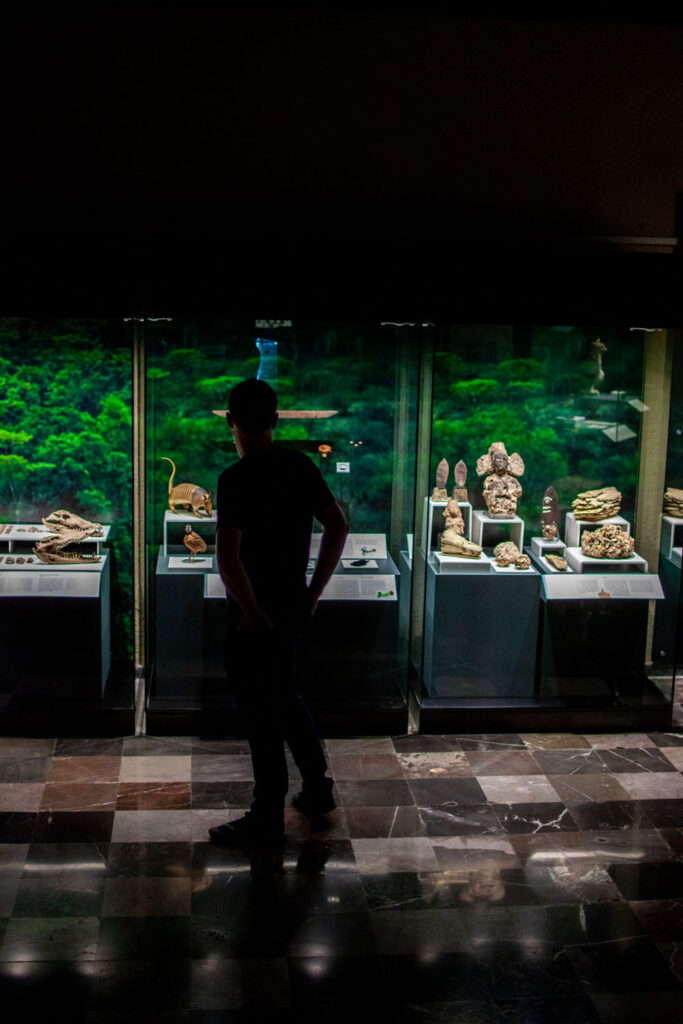
Room 7 – Agriculture
One of the most ingenious and significant innovations that propelled the Mexica people’s empire was the use of chinampas. These Mexican chinampas, a form of ancient agricultural system, transformed the shallow lakes of the Valley of Mexico into fertile lands. The creation of these ‘floating gardens’ involved piling mud and vegetation into rectangular, raised beds separated by canals, anchored by willow trees, and cultivated with maize, beans, squash, and tomatoes. This pioneering technique enabled year-round agriculture, high productivity, and efficient water management, playing a pivotal role in sustaining large urban populations like Tenochtitlan.
Throughout this room, there are also many objects associated with various gods associated with agriculture, such as Chalchiuhtlicue, Chicomecoatl, and Xipe-Totex.
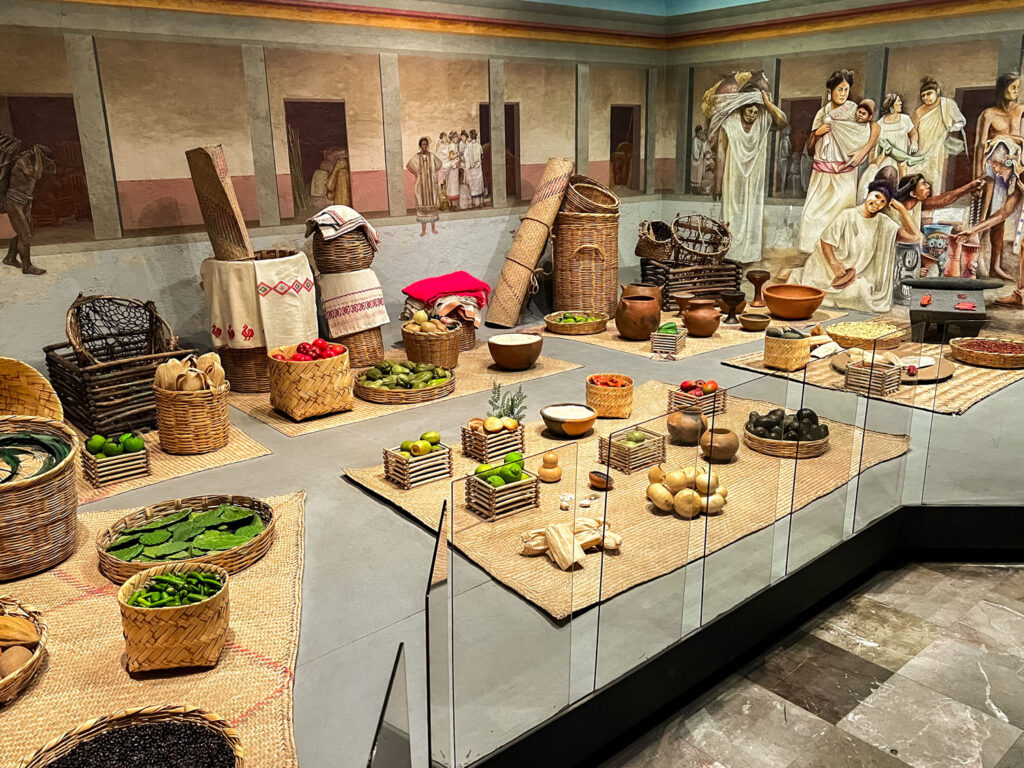
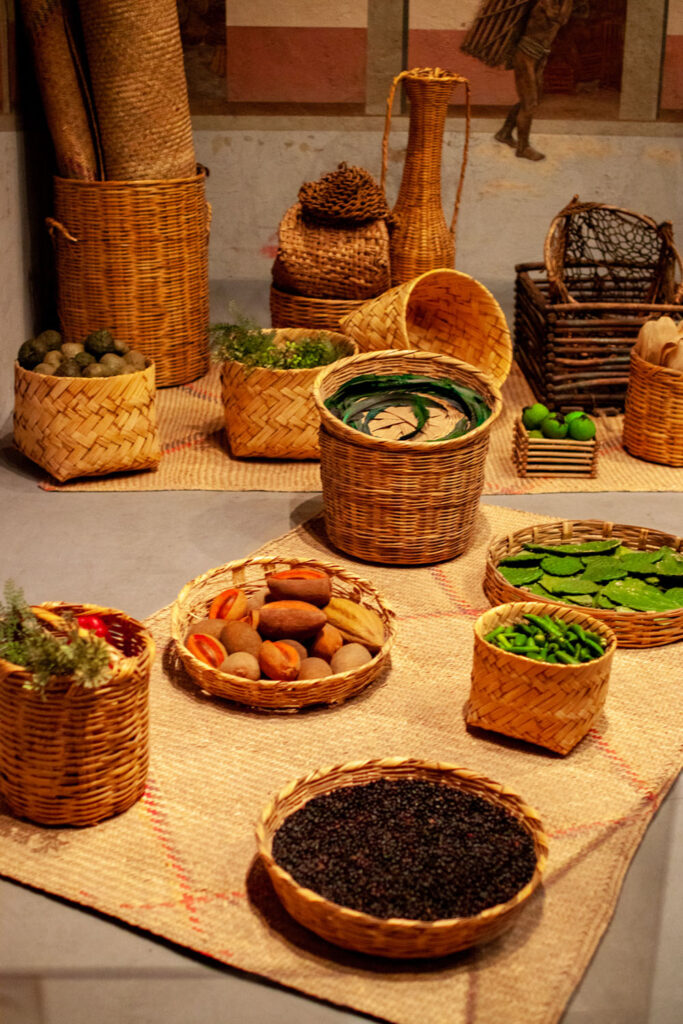
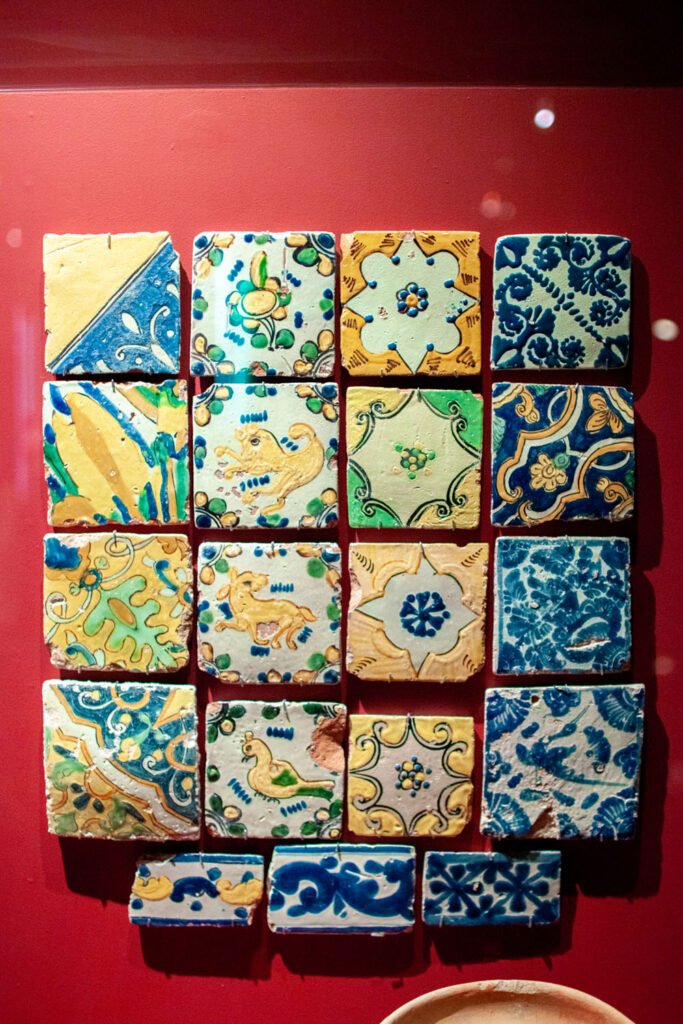
Room 8 – Historical Archeology
The last room in the exhibition space details the arrival of the Spanish in 1591 and the subsequent horrific conquest in 1521. The objects inside these parts of the museum demonstrate the stark differences between the Spanish and Aztec cultures and the eventual war that would erupt between them.
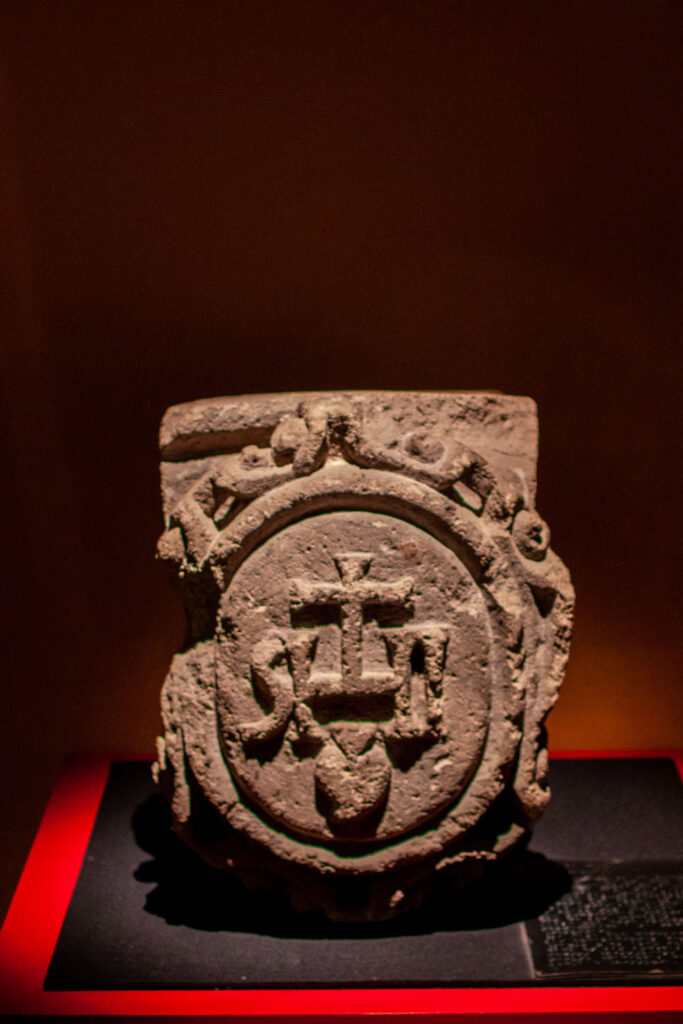
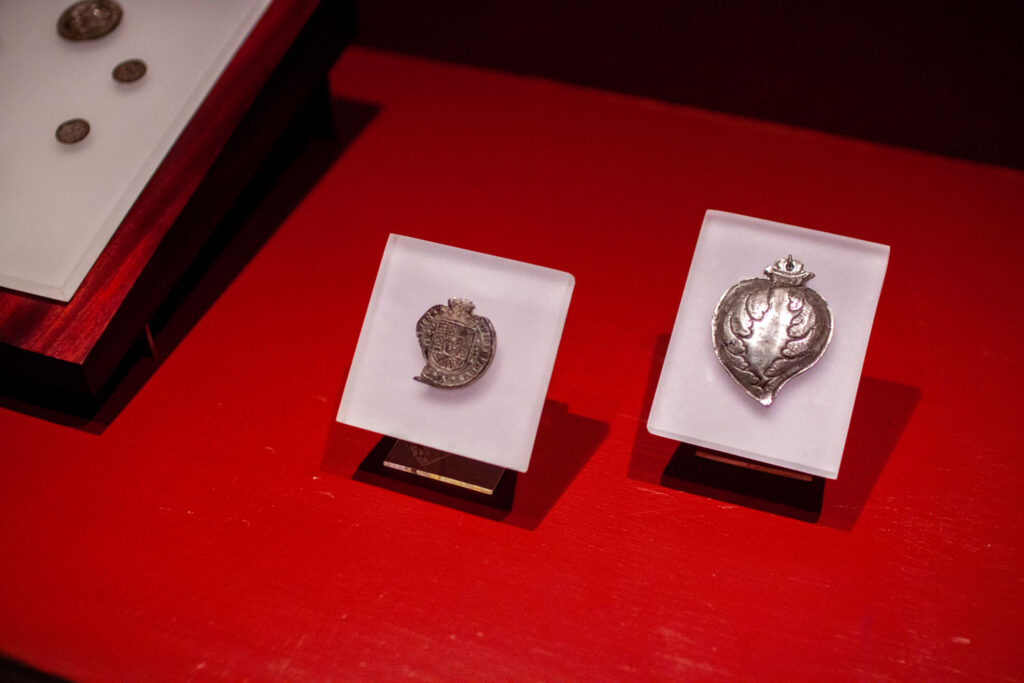
I hope you have enjoyed our visit to the Templo Mayor Museum, and throughout this self-guided tour, you’ve gained profound insights into the rich cultural and religious tapestry of the Mexica civilization. The architectural and artistic achievements of the Mexica people found inside the ruins of the Templo Mayor help connect you to the timeless legacy of one of Mexico City’s most significant historical sites.
Happy Travels, Adventurers!








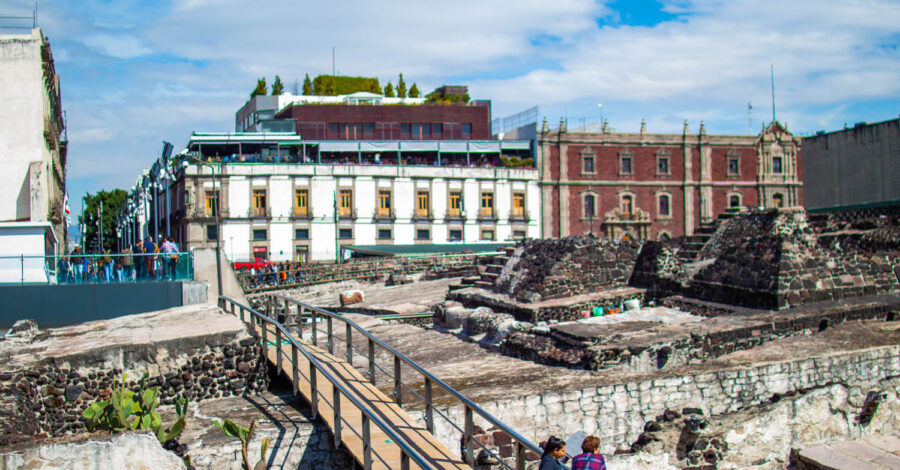
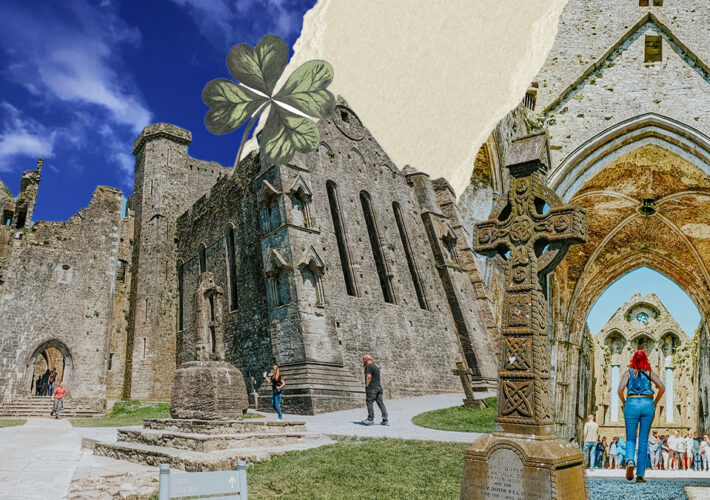
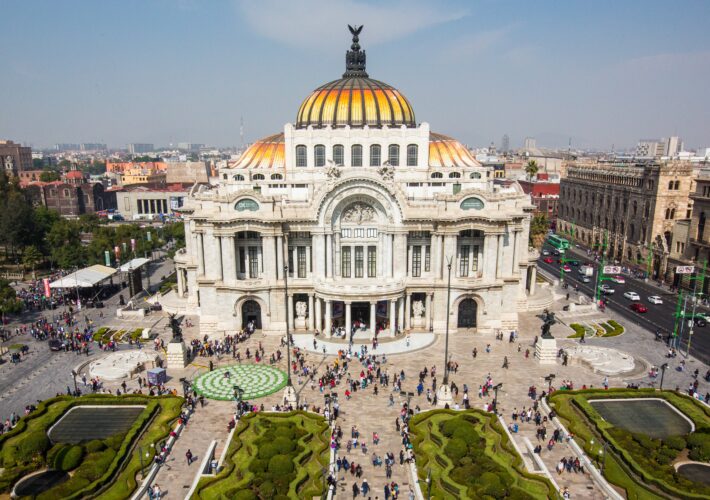
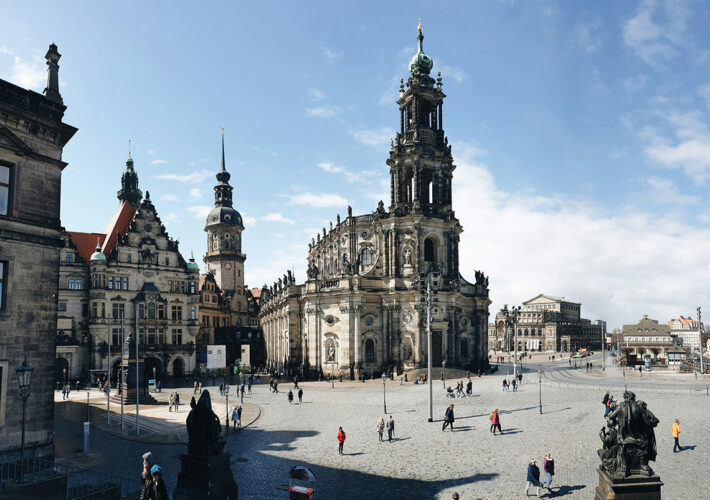

Leave a Comment